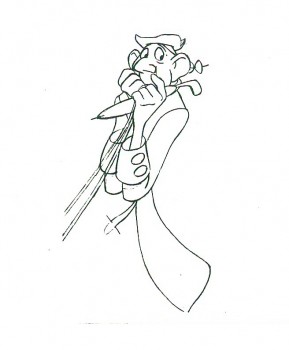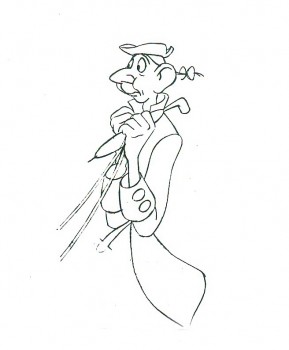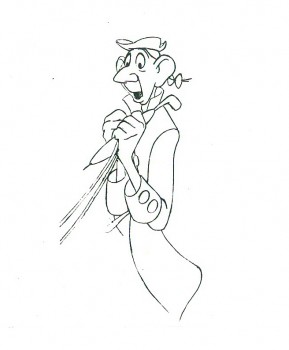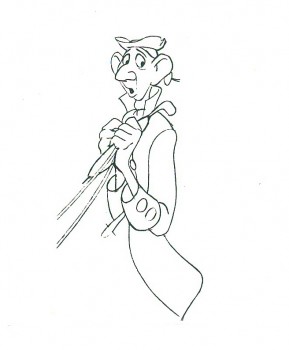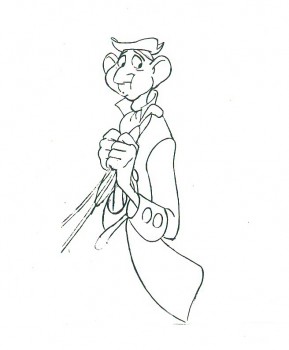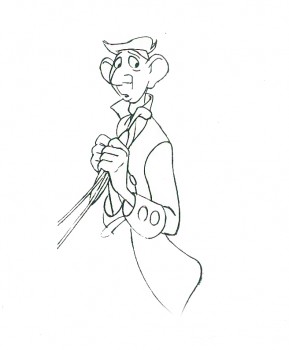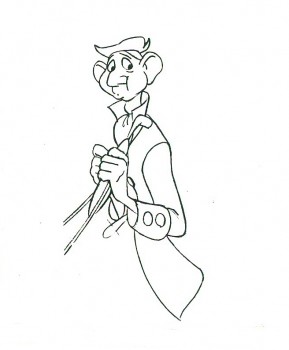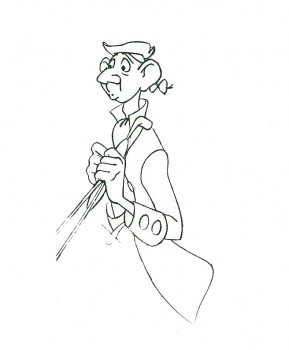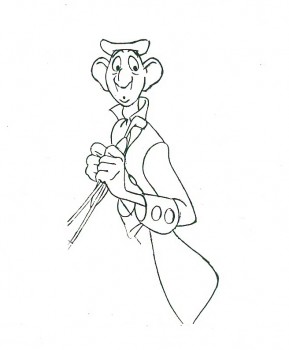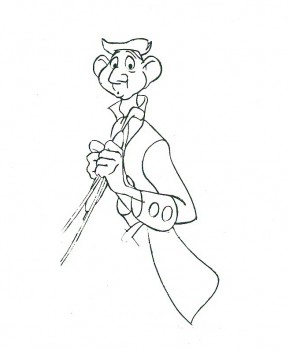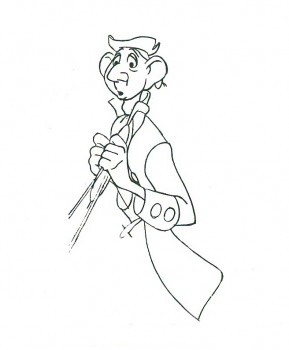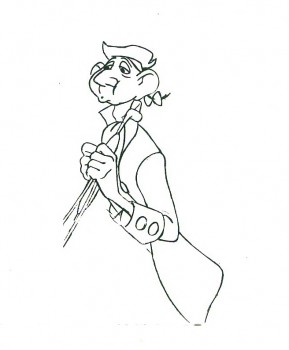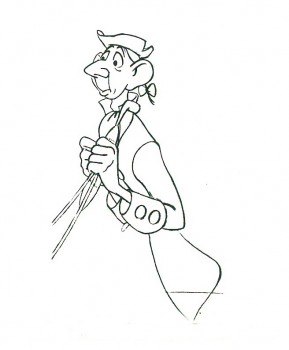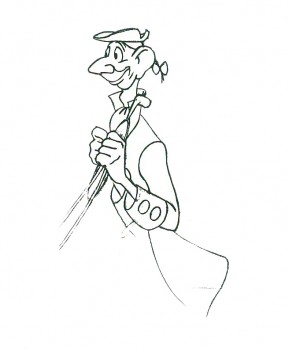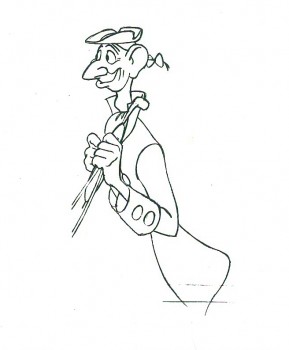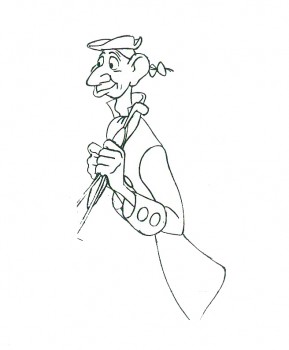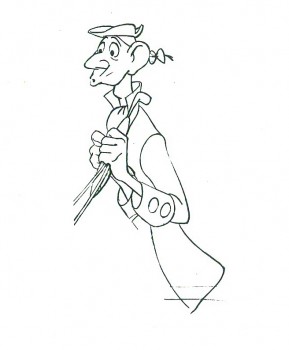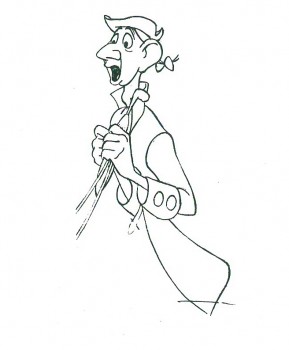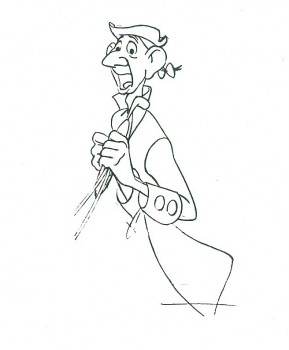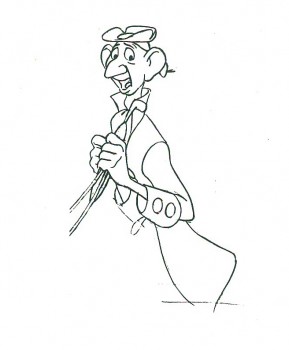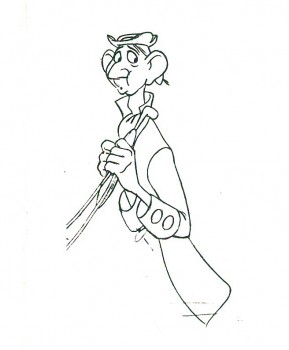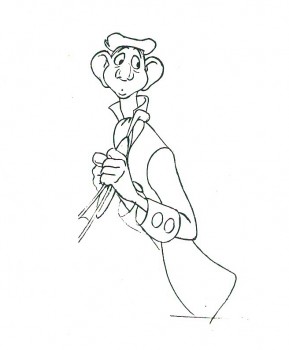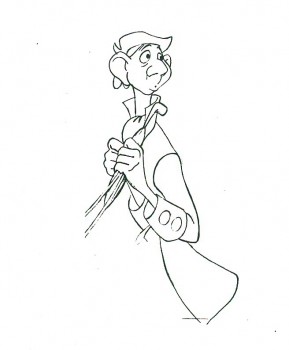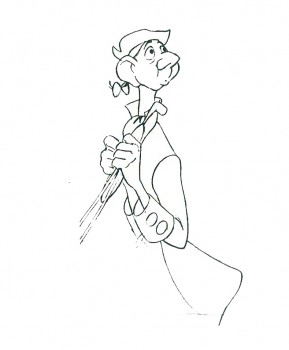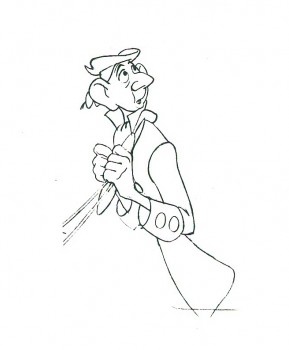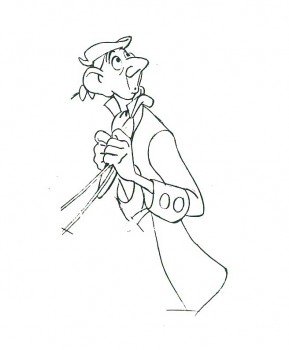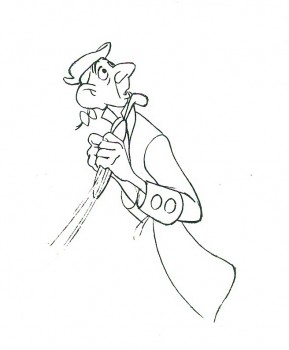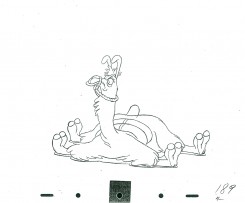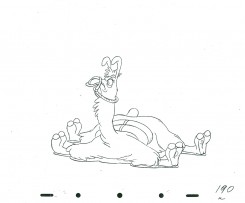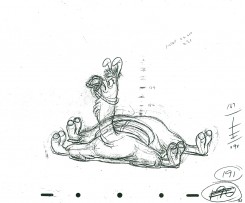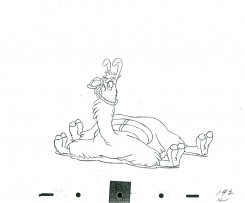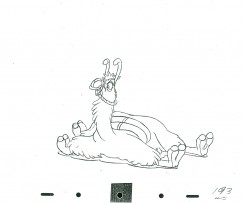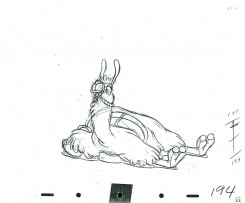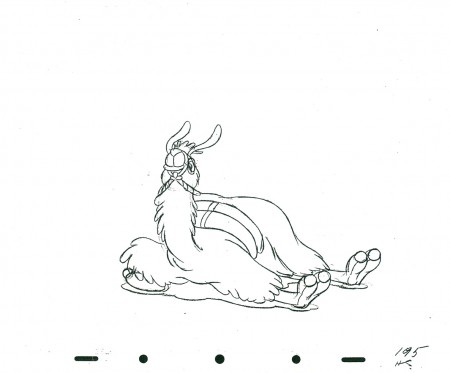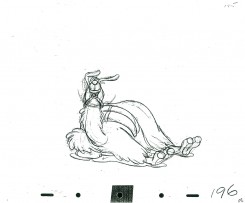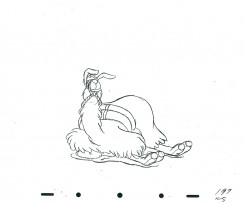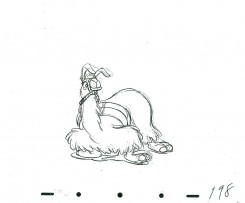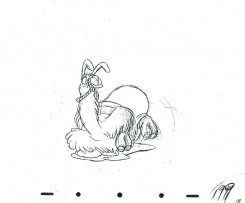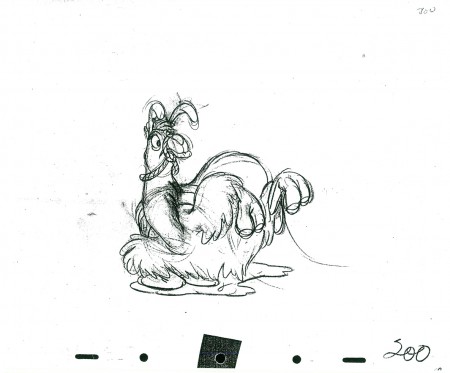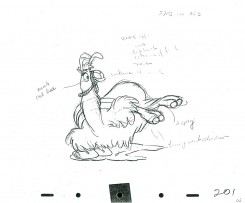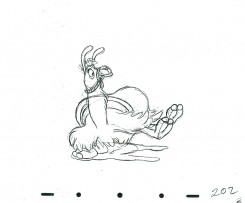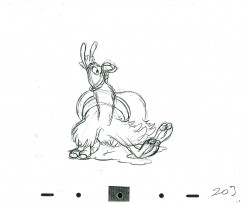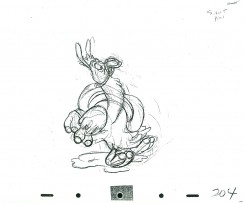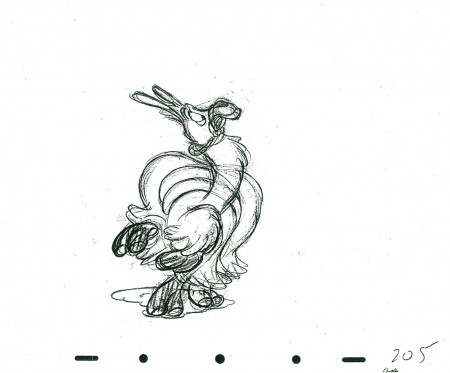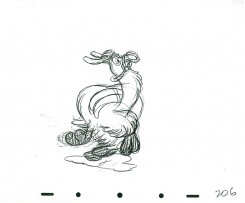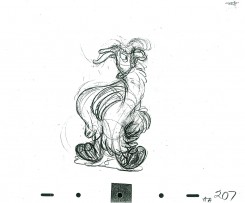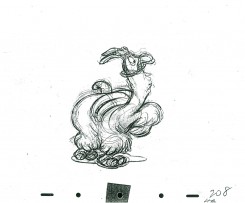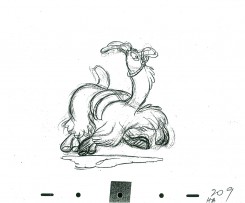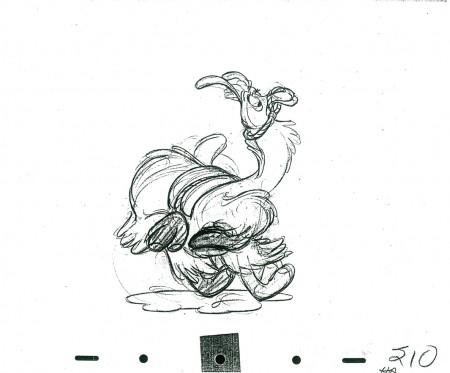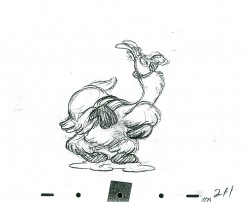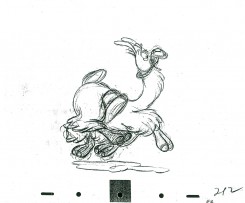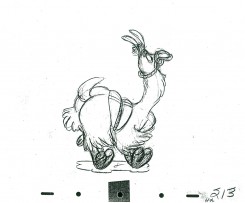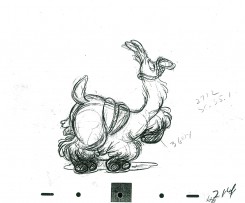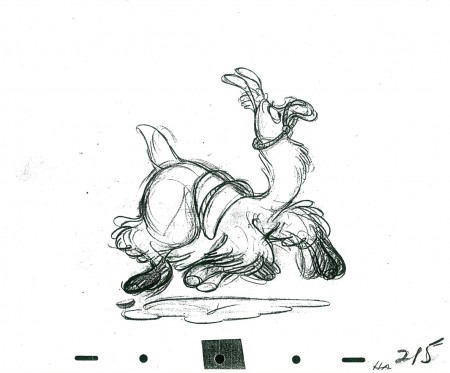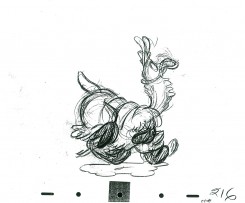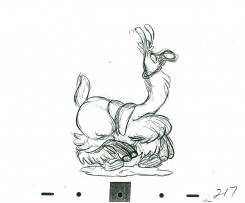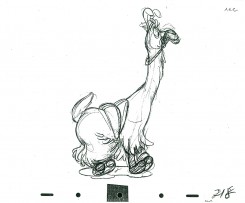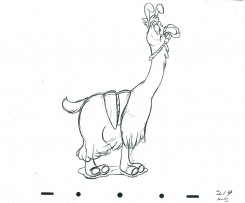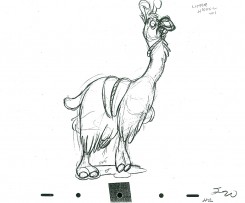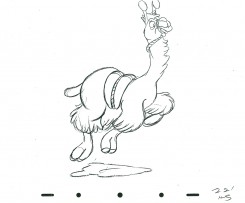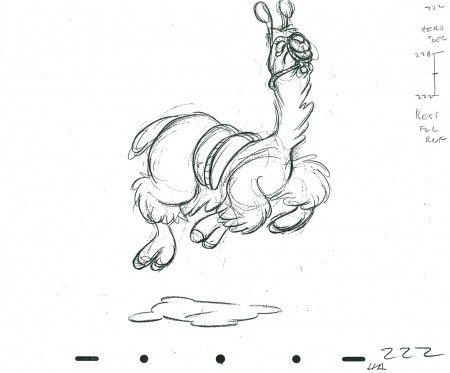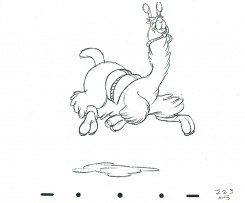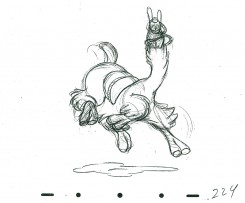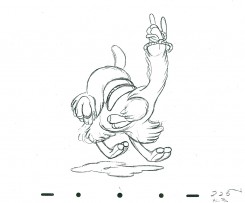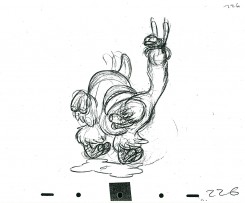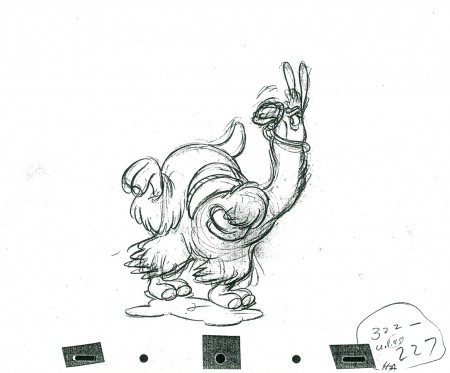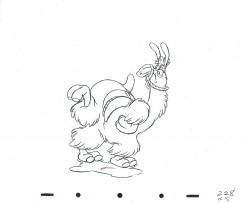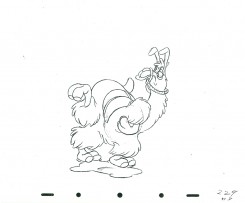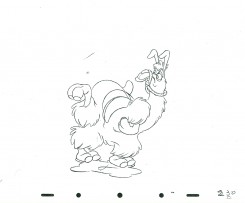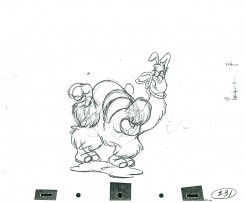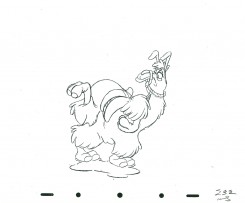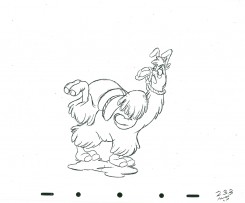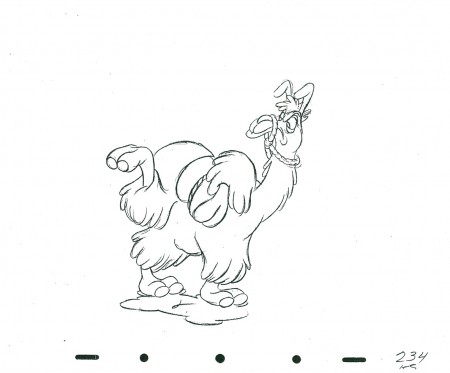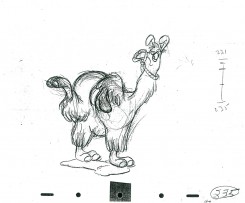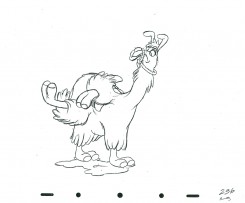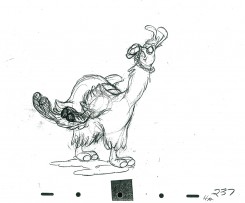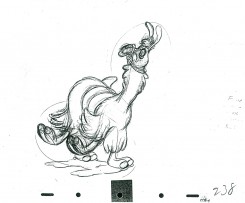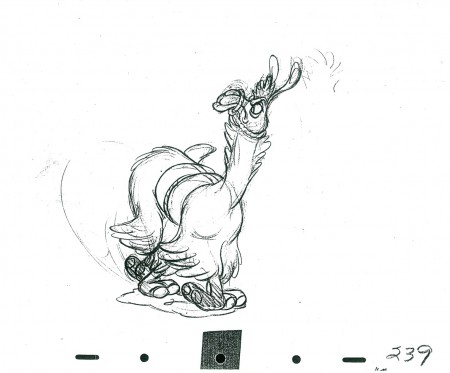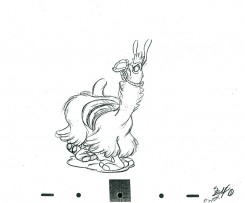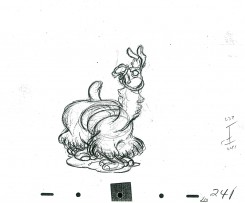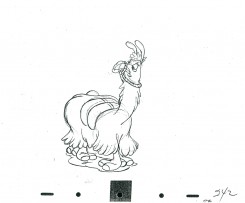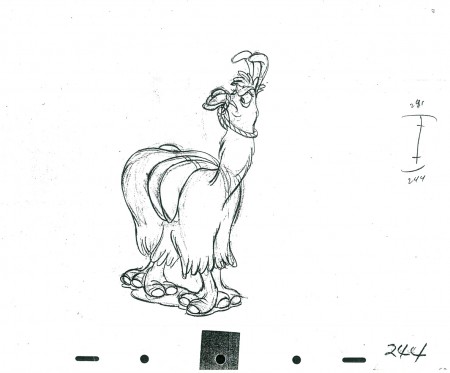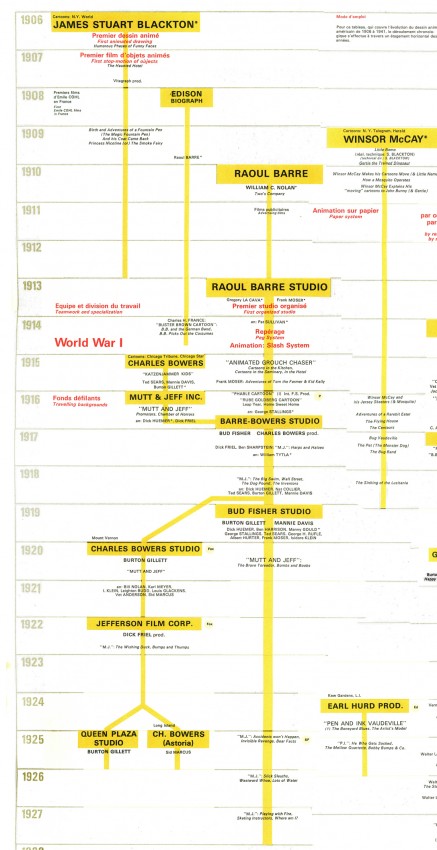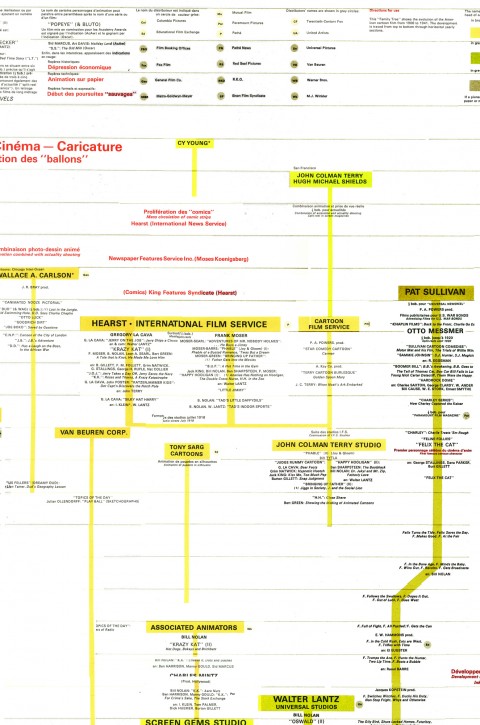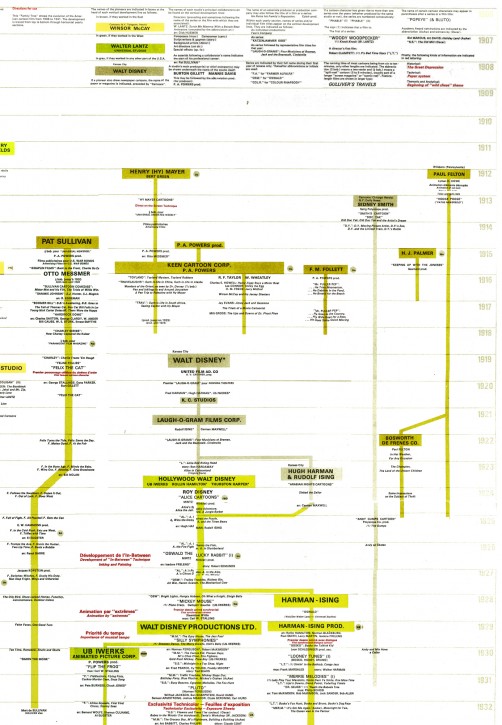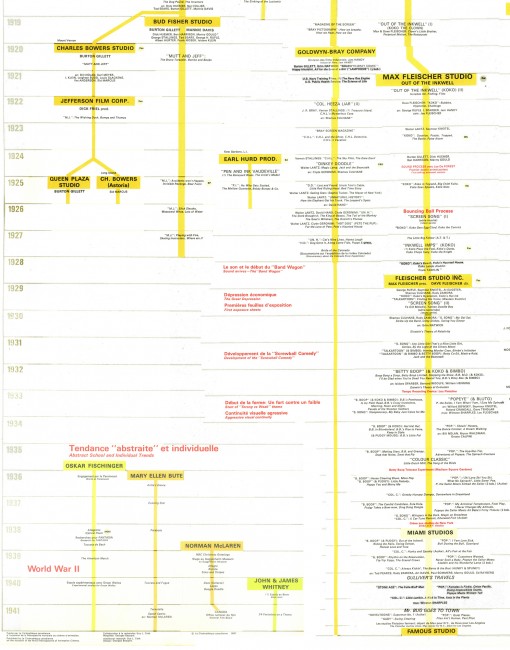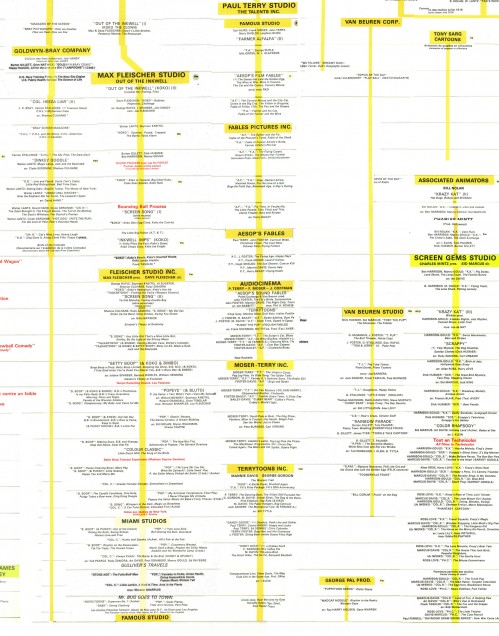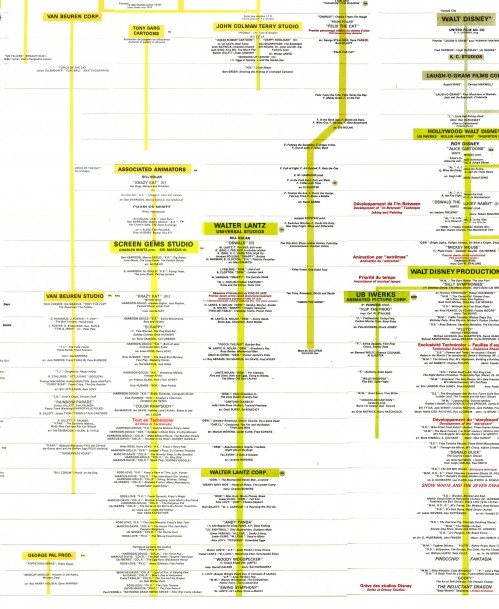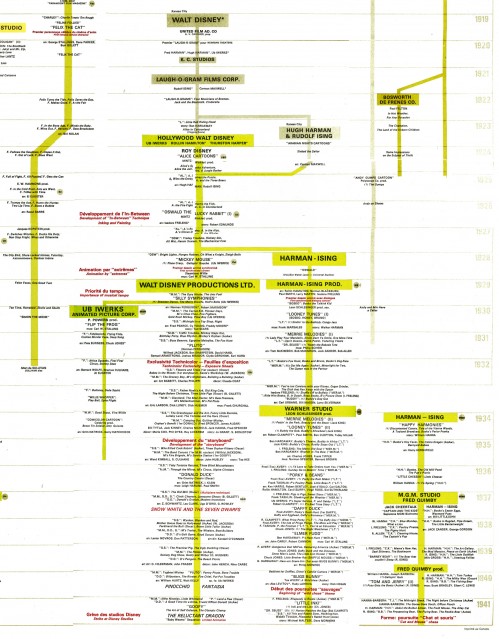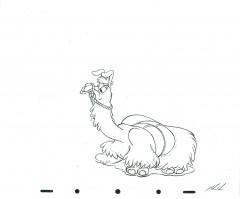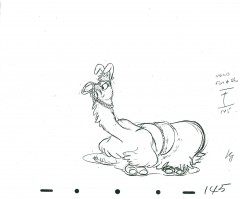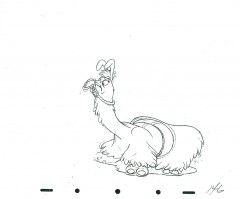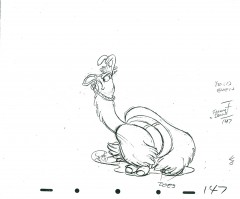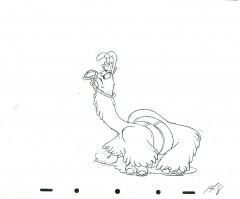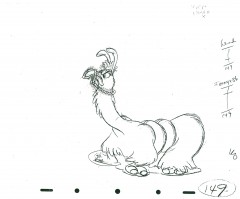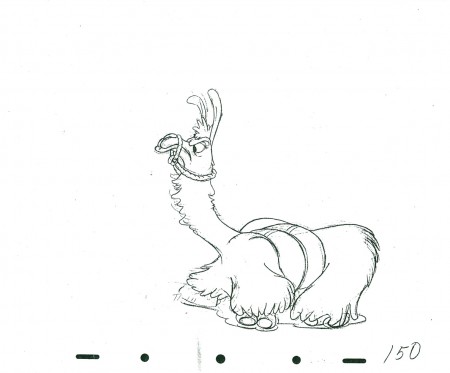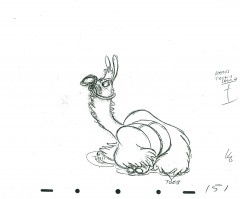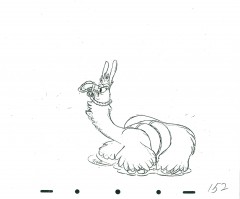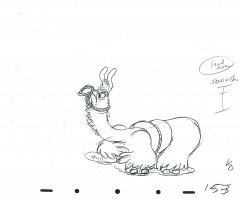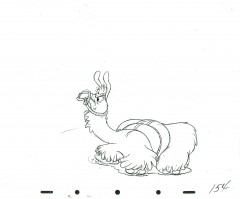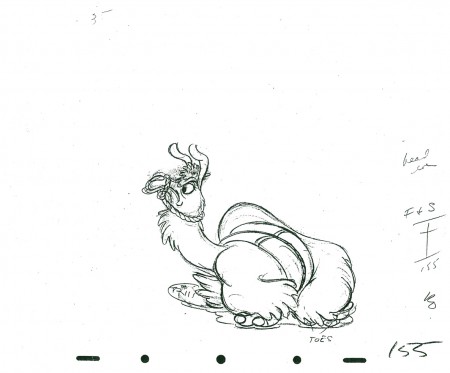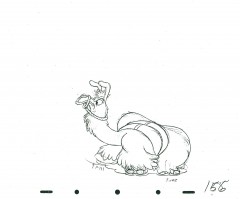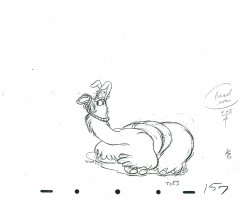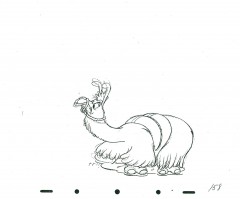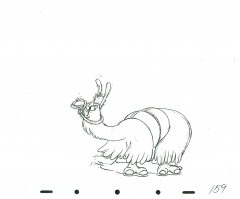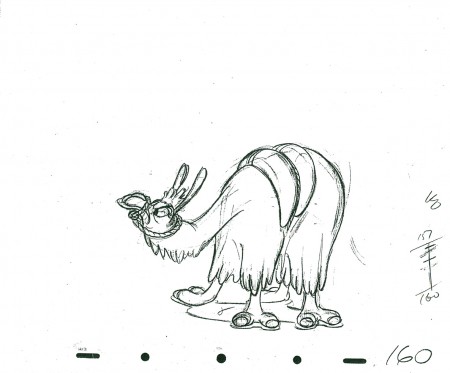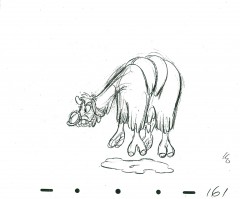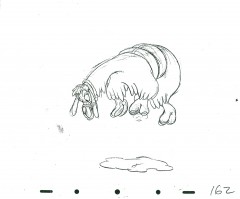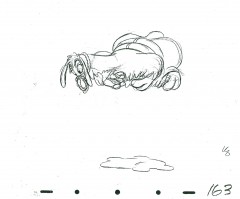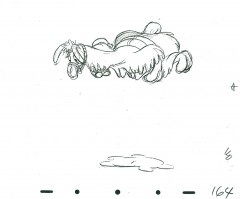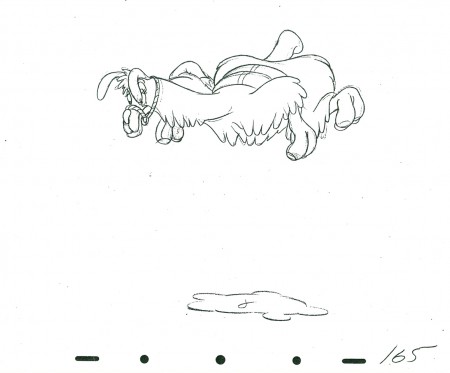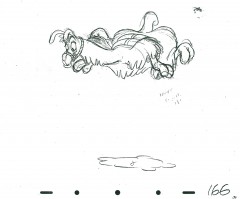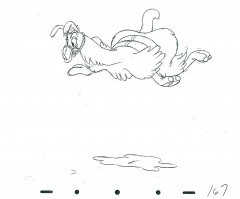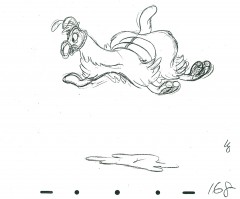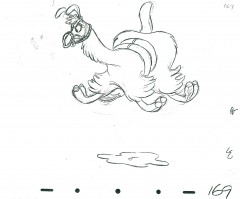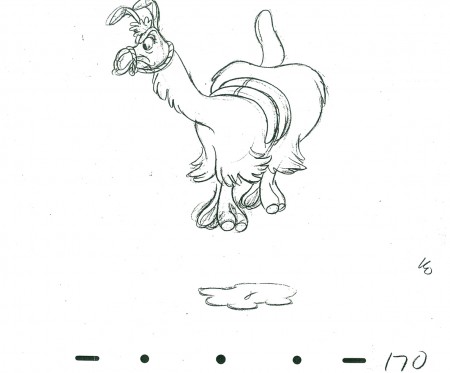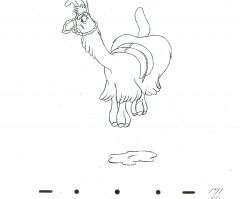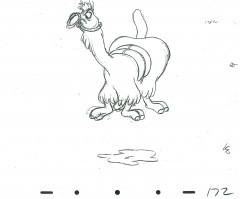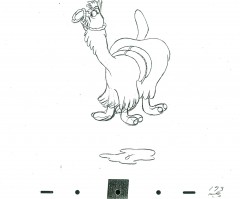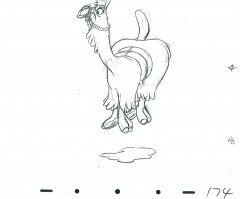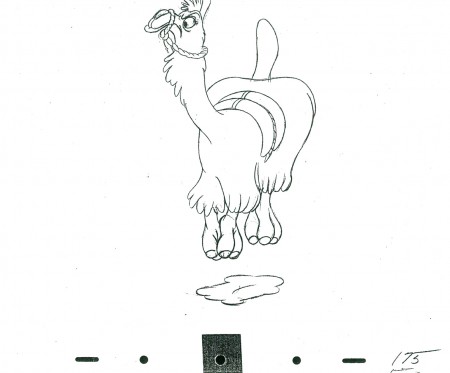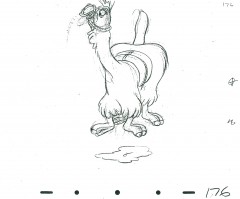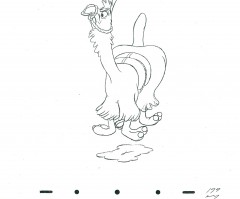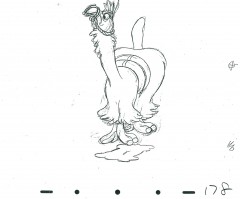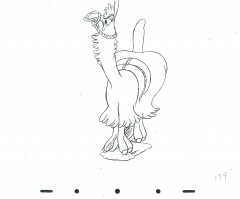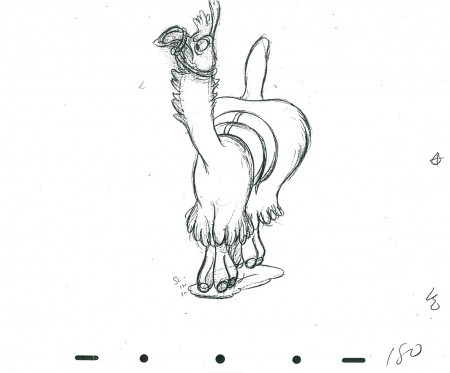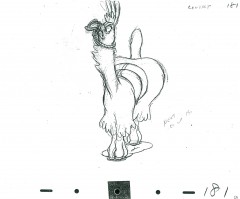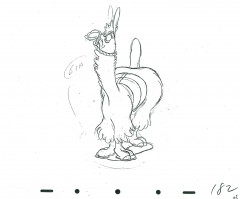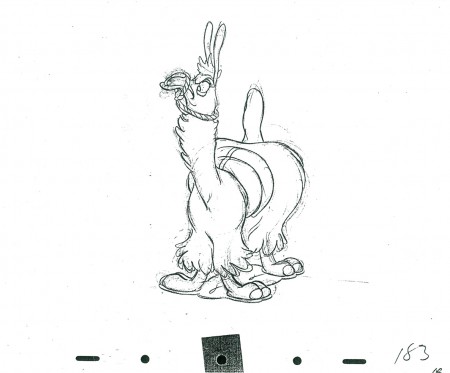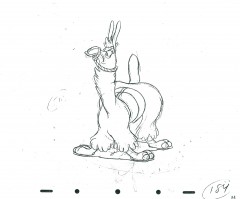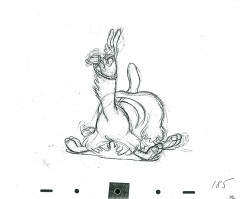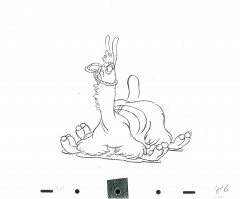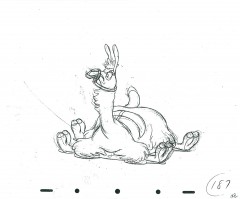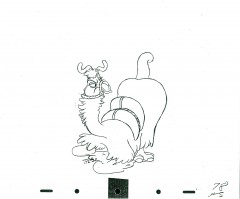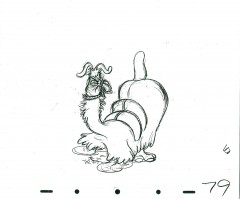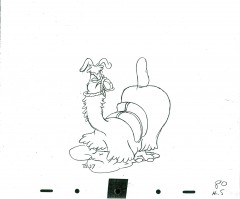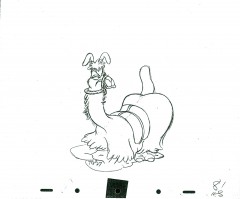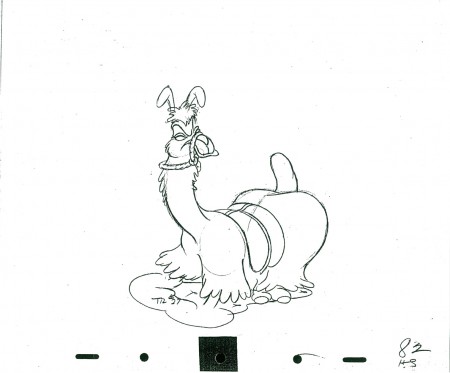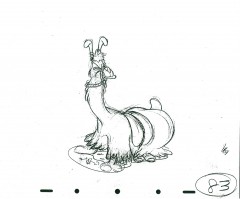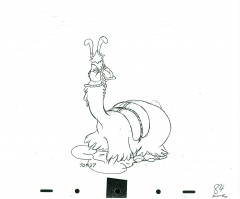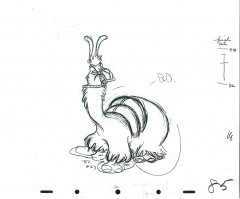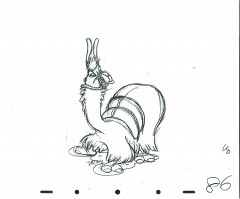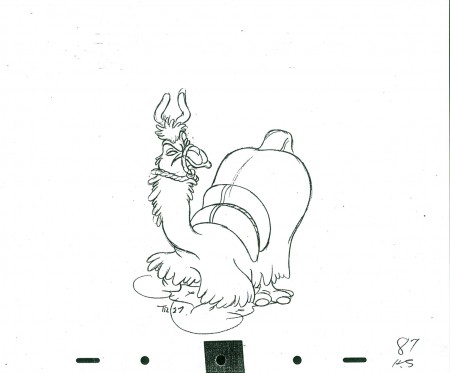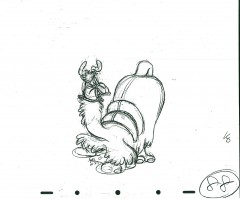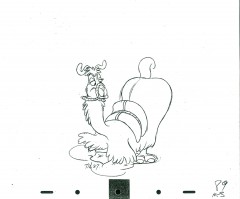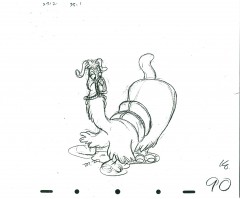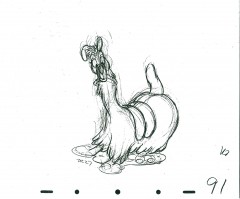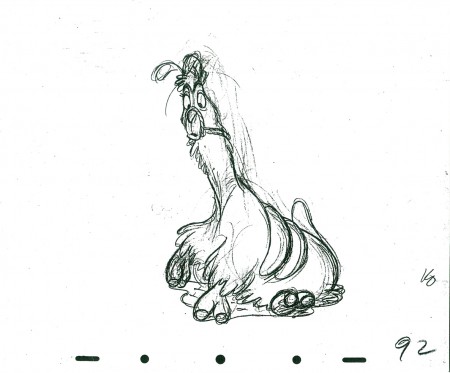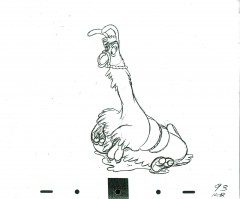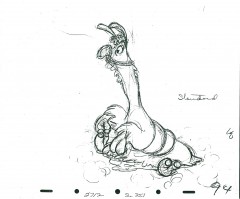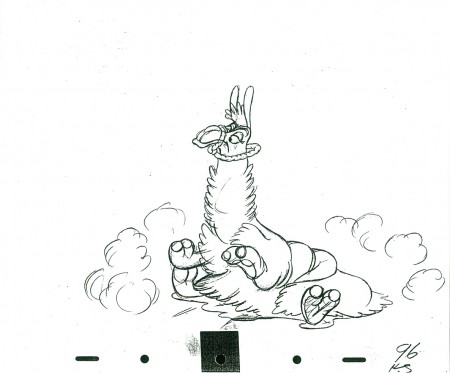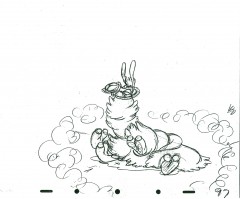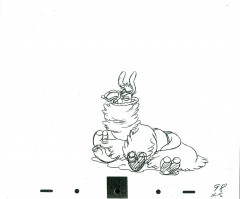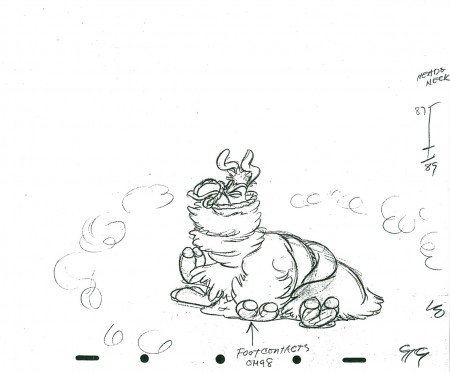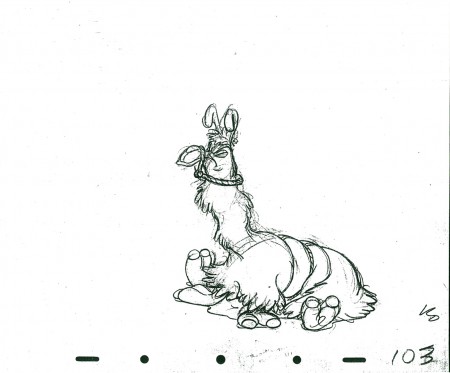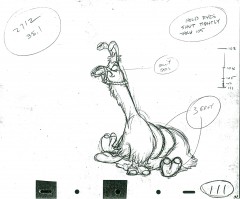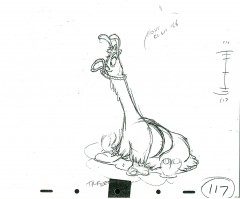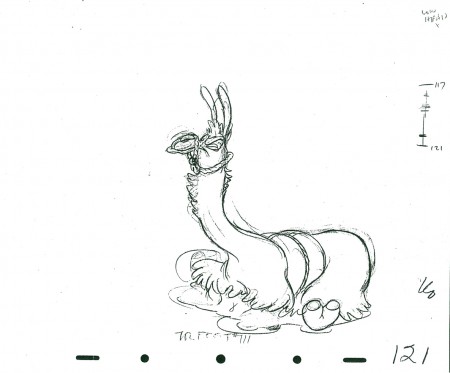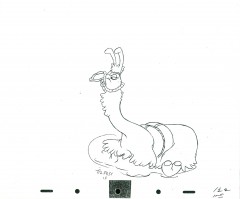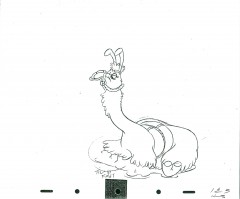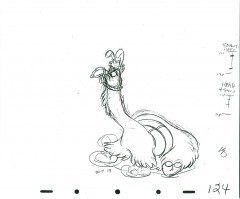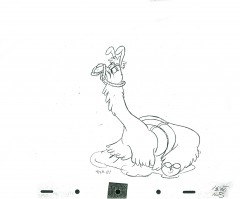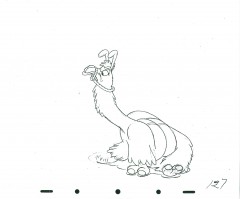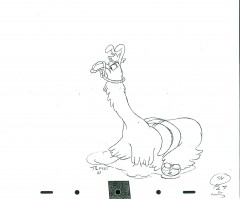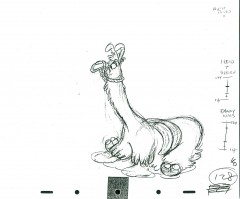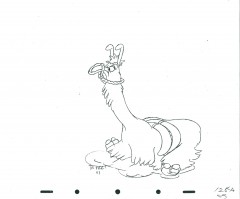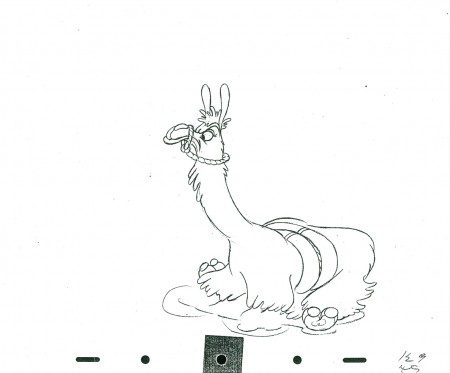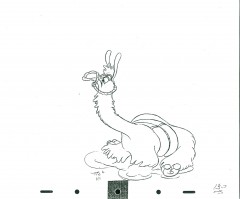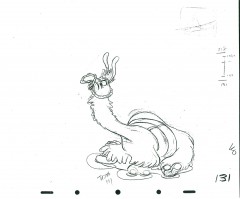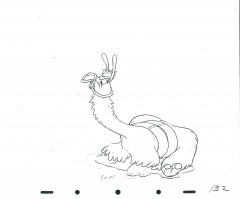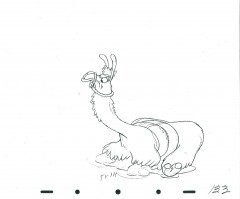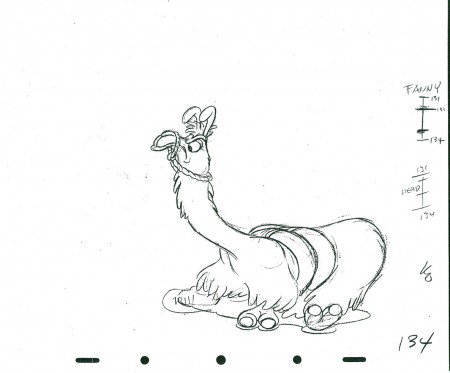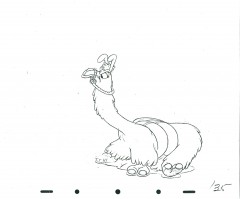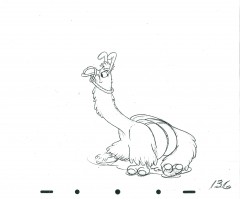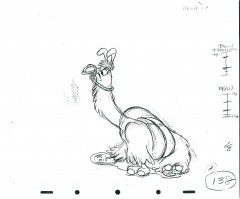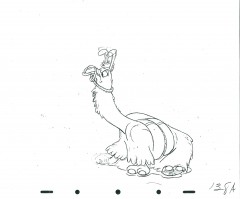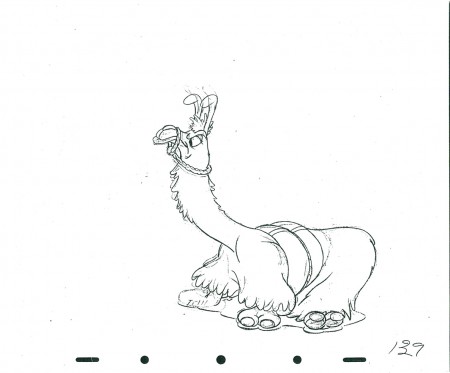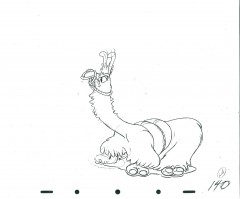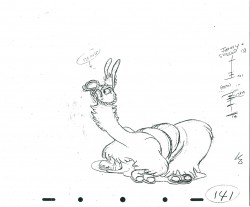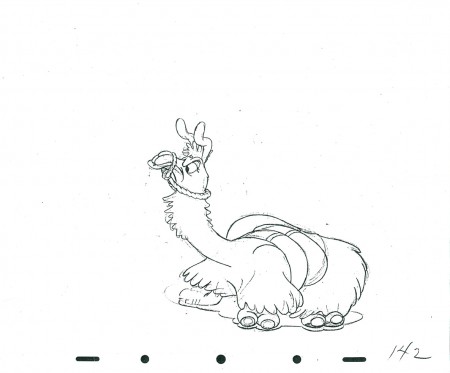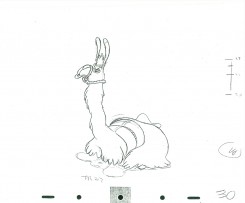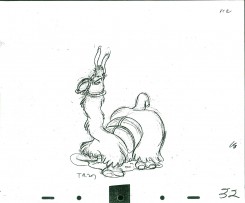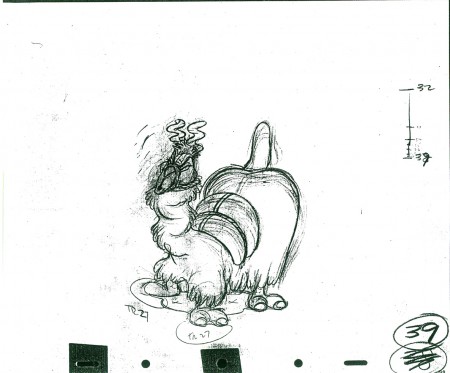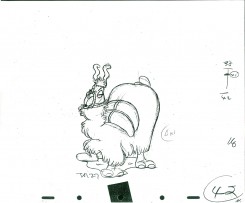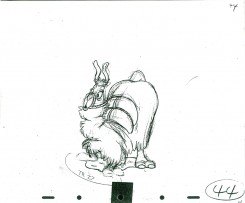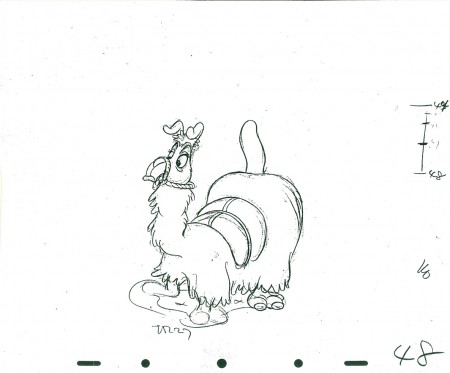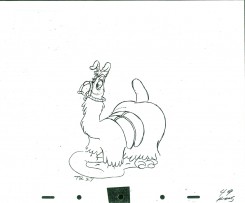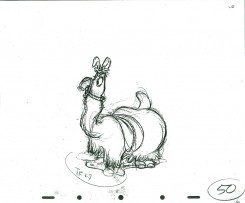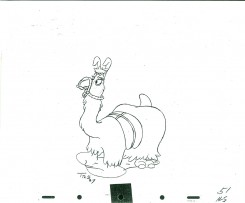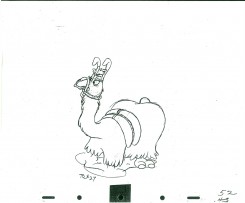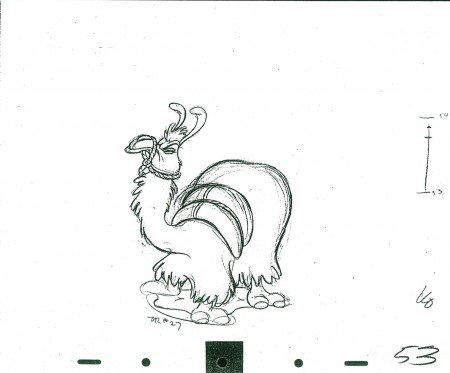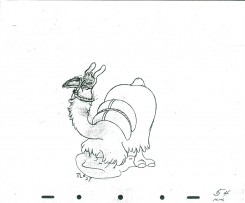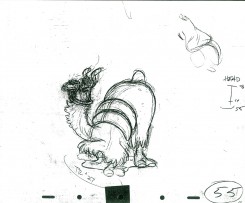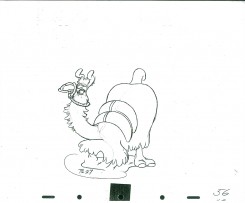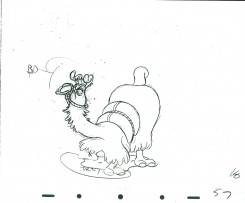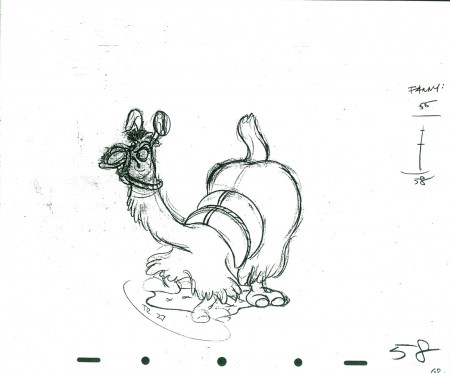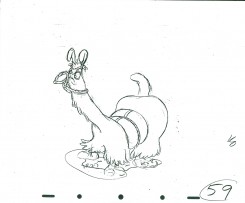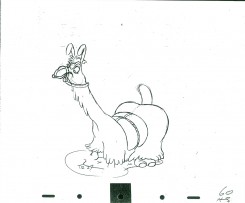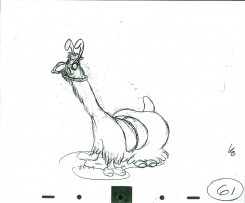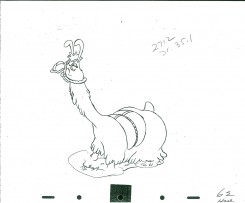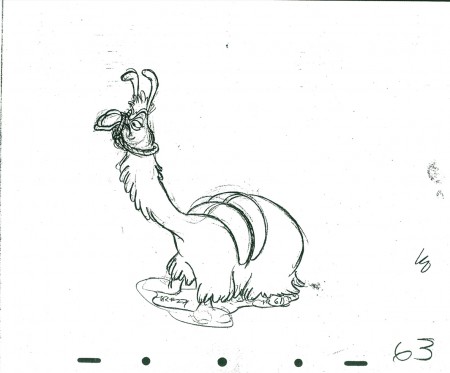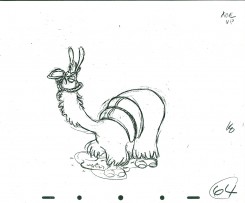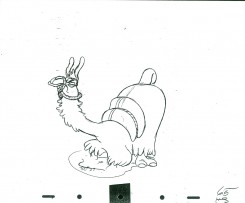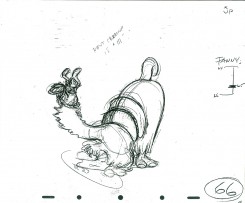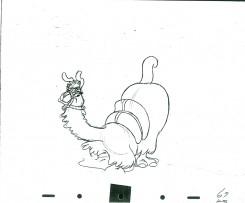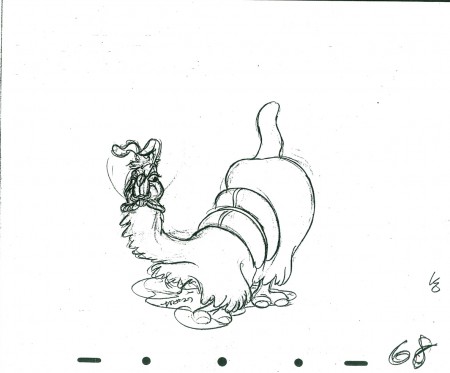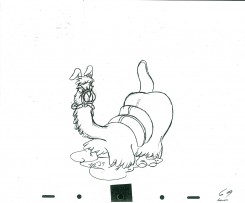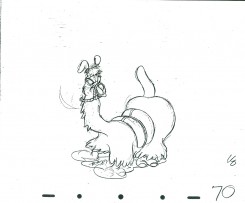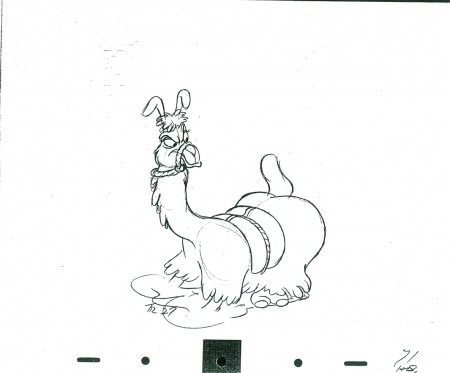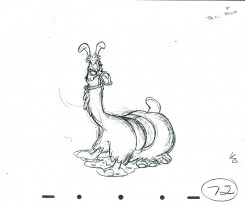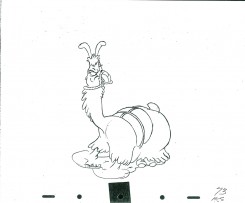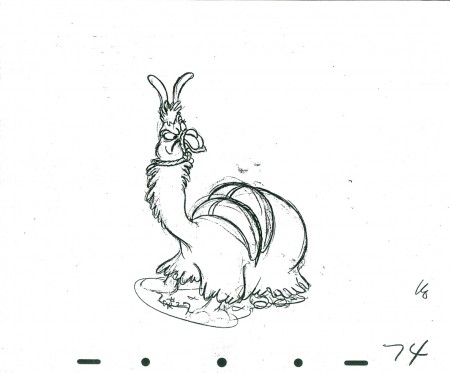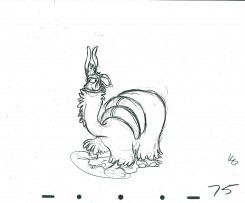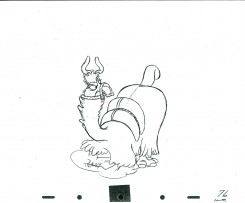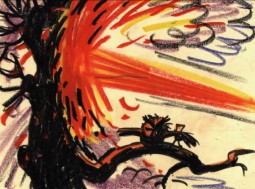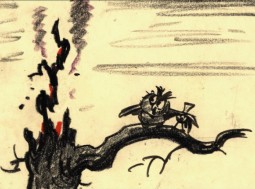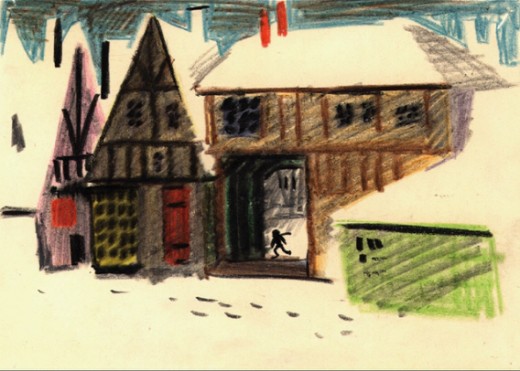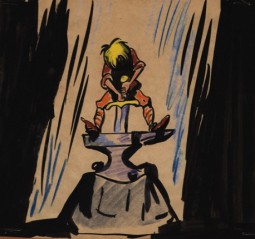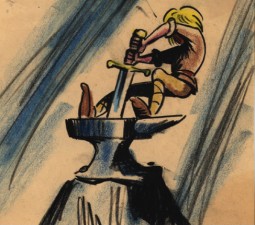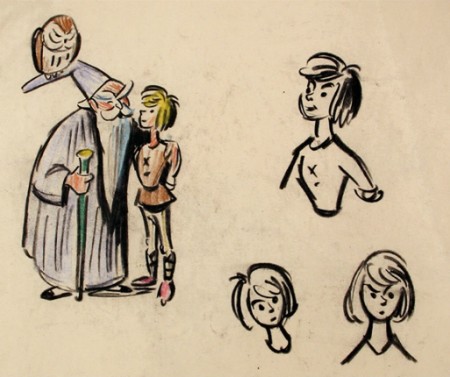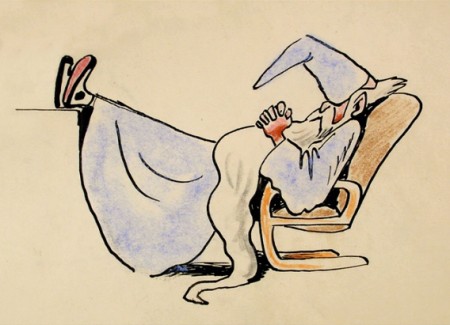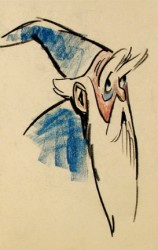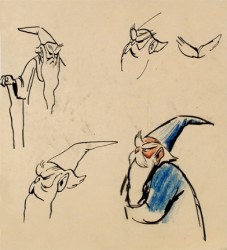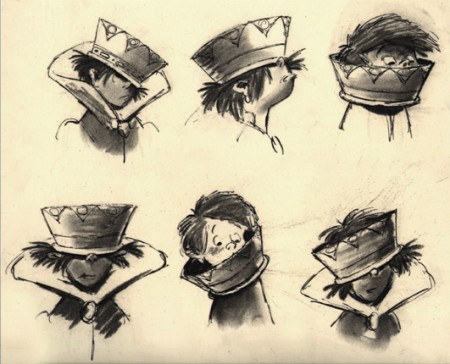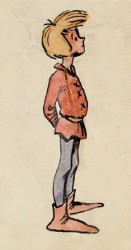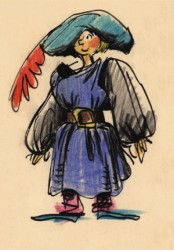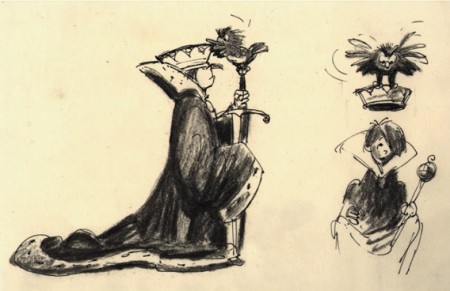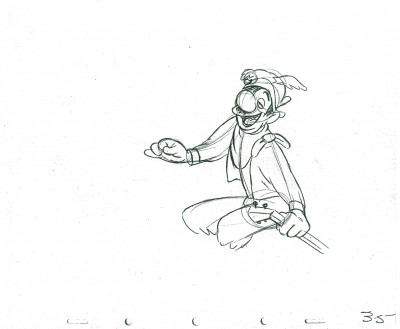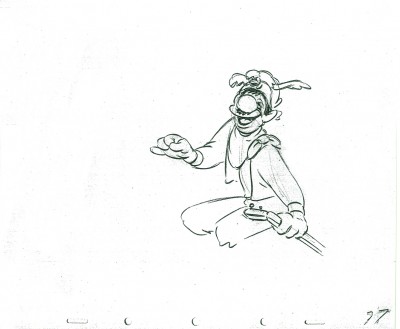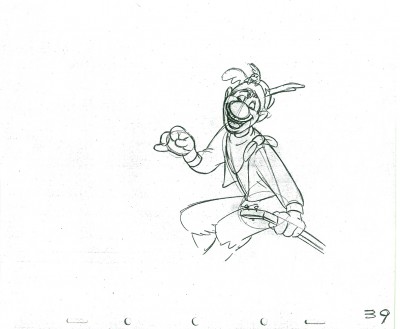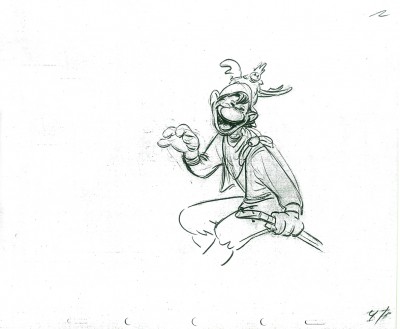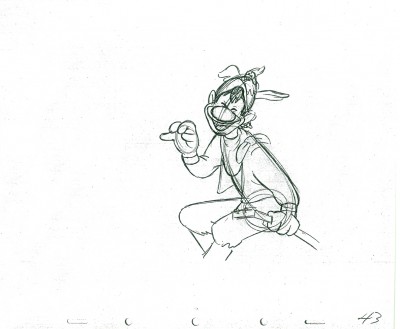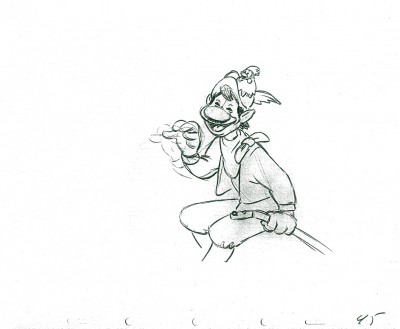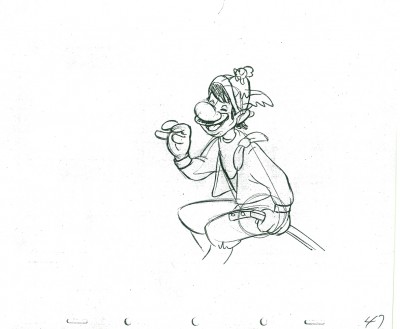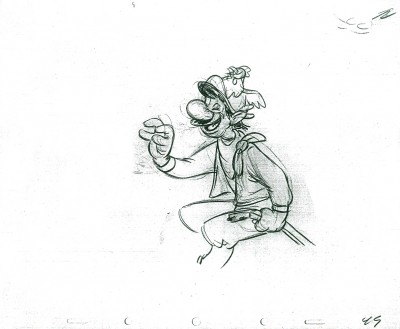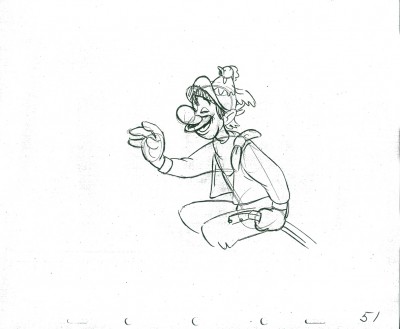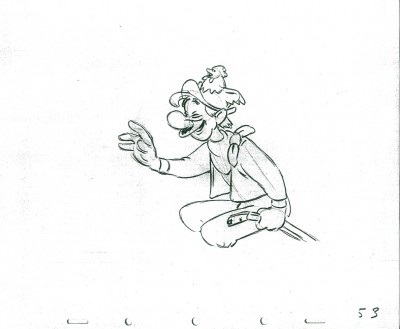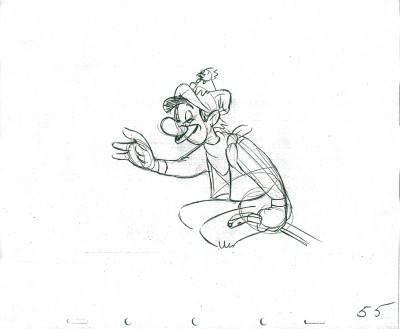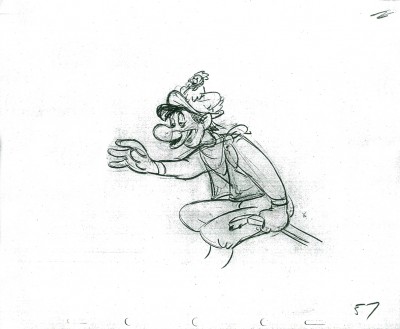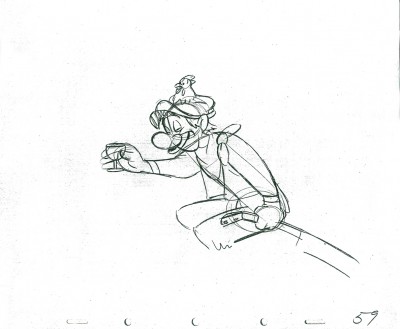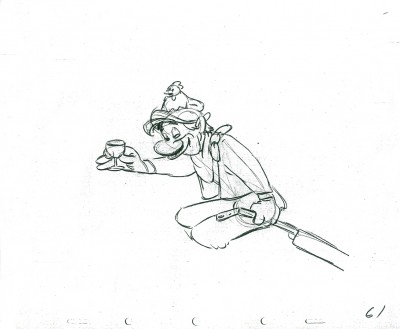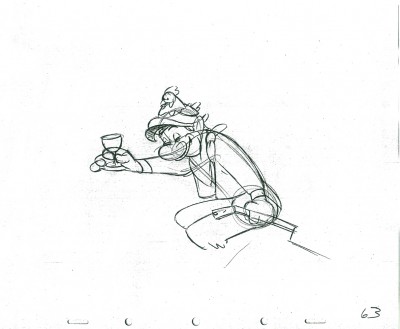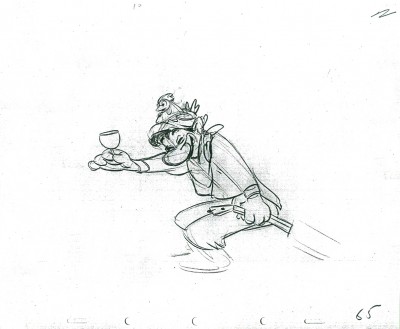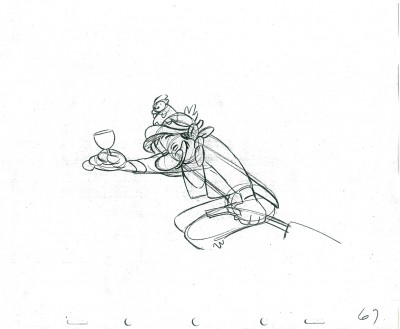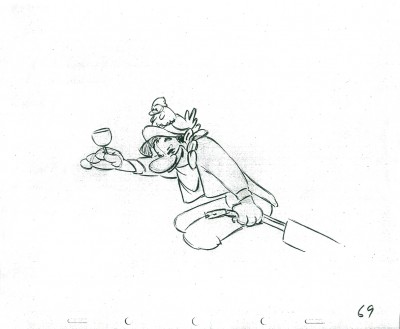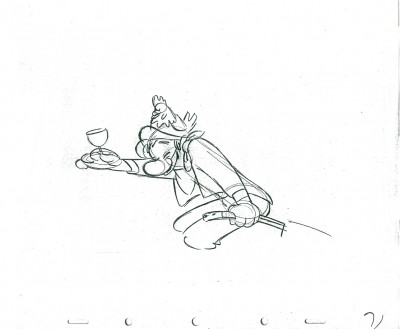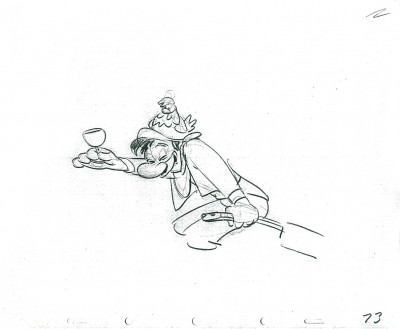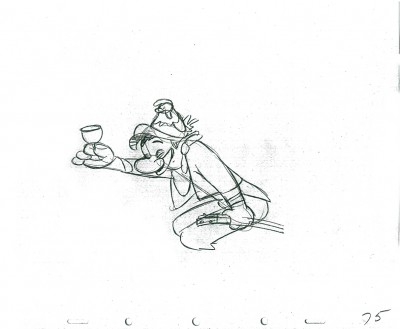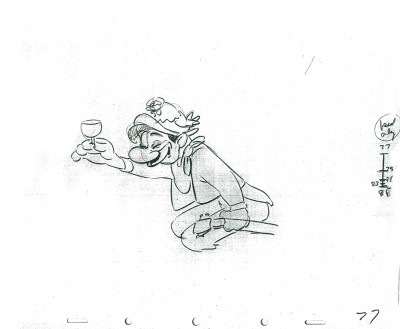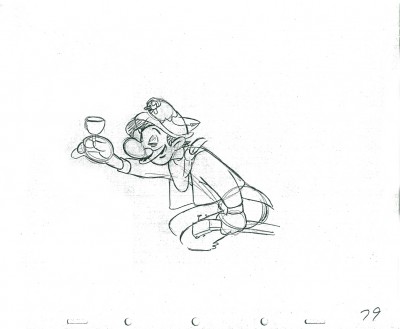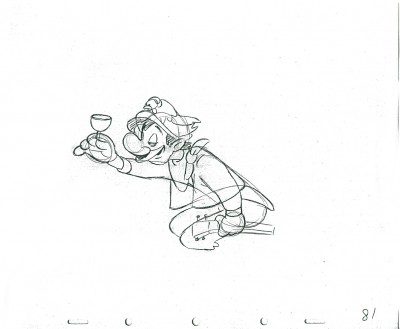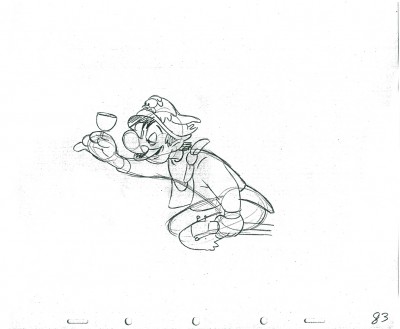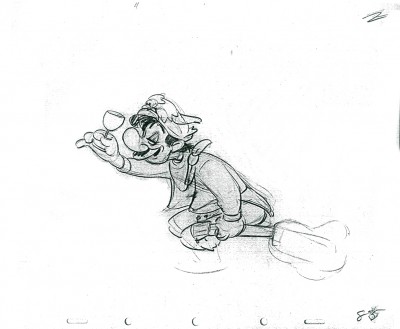Category ArchiveAnimation Artifacts
Animation &Animation Artifacts &Disney 11 Apr 2011 06:10 am
Ichabod’s Ride
- Frank Thomas did the brilliant ride of Ichabod Crane about to meet the Headless Horseman. Here’s a flip book that was prepared by Disney which was published in The Illusion of Life, Frank Thomas and Ollie Johnston’s book (pg. 467-521). I have a photographic copy of the images and can post them significantly larger than the book offers. I’ve also done a QT for them.
The registration isn’t all it could be. I know the N/S is correct, but have no guidance for the E/W so took a stab at it. I’m also assuming that many of the drawings are not included, so I just exposed it on threes.
The assisting on this scene is beautiful (as is the animation.)
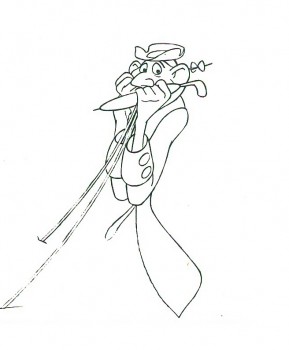 1
________________________
1
________________________
Here’s a QT of the scene with drawings exposed on threes to accomodate some missing drawings.
There have also been published a few other images from a continuation of this scene by Thomas. I’ve scanned those and post them below.
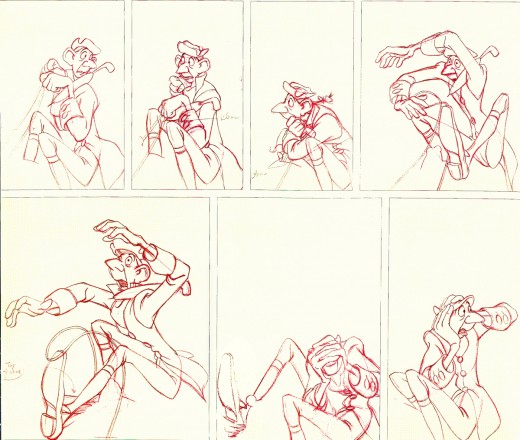
This page is from John Canemaker’s book The Nine Old Men and
the Art of Animation, with the Frank Thomas chapter.
They look like they immediately follow the images chosen for the flip book.
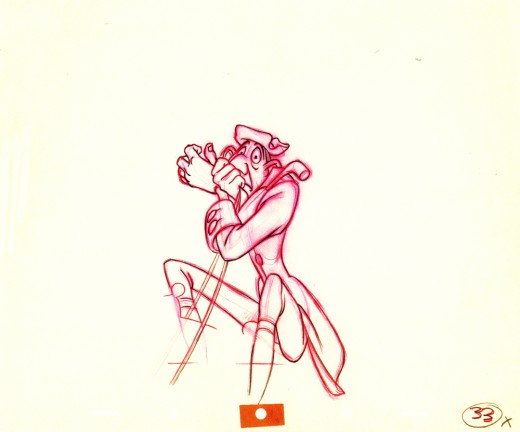
This image comes from the Walt Disney Archive series: Animation.
Animation Artifacts &Independent Animation 09 Apr 2011 07:17 am
Ends and Odds
- Here’s a little tidbit I thought I’d share. It’s the top of a film can for a 16mm print of a William Tytla Productions studio commercial: Hostess Twinkies: Knight
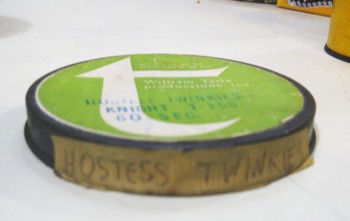
side view of the can top.
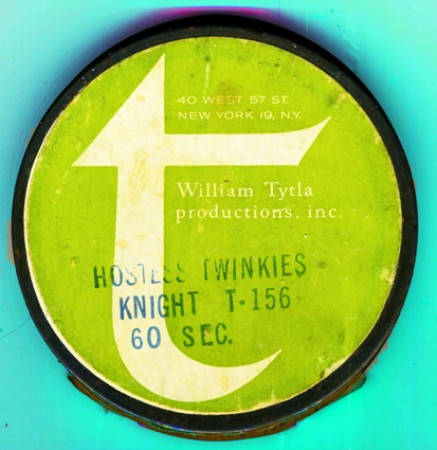
Overhead view, including the studio address:
40 West 57th Street, NYC 19, NY
Back in the day (before video) 16mm prints of commercials were sent out to the tv stations to air the commercials. All studios had hundreds of these film cans in storage.
This artifact was given to me by John Canemaker.
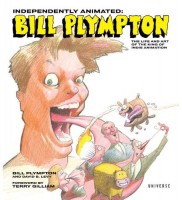
- Bill Plympton will have a book signing/party in New York for his book Independently Animated: Bill Plympton the Life and Art of the King of Independent Animation. The event will take place on April 27th at the NY Society of Illustrators, 128 East 63rd Street. There will be live music by Nicole Renaud, world premiere short films, and an illustrated talk by Bill Plympton.
TICKETS
$15 non-members, $10 members, $7 students
RSVP@societyillustrators.org or
call Katie Blocher 212 838 2560
.
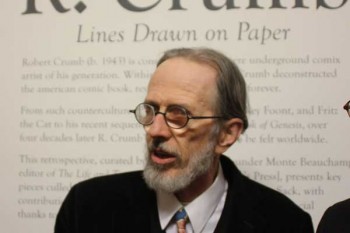
- And speaking of the Society of Illustrators, they’re currently hosting an exhibit retrospective of the art of R. Crumb. Entitled Lines Drawn on Paper, the show can be seen for free at 128 East 63rd Street and will run through April 30th.
.
- John Schnall (Quality Schnallity) has another wonderful video on his site. I Trust You. Take a short trip via click and watch it; the man has a unique sense of humor.
.
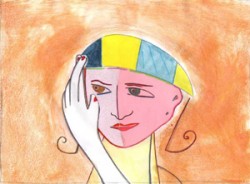 - Emily Hubley will host a showing of some of her films this coming Monday eventing, April 11th, at the Big Screen Project, 6th Avenue between 29th and 30th. (Look for the “Food Parc” on the west side of the street. Enter and keep going back until you hit the bar/with seats. Look up and outside.)
- Emily Hubley will host a showing of some of her films this coming Monday eventing, April 11th, at the Big Screen Project, 6th Avenue between 29th and 30th. (Look for the “Food Parc” on the west side of the street. Enter and keep going back until you hit the bar/with seats. Look up and outside.)Admission is free.
The films to be screened include:
One Self: Fish/Girl
Enough
The Tower (made w Georgia Hubley)
Set Set Spike
Delivery Man
Octave
Blake Ball
The films of Jeff Scher will follow at the same venue, same location on Wednesday, April 13th.
.
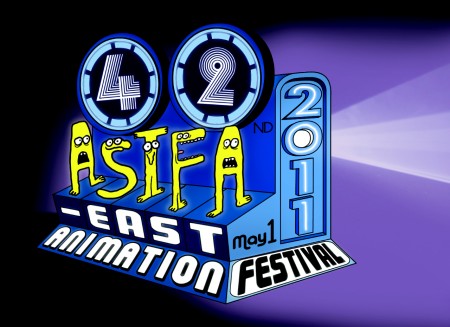
The ASIFA East Animation Festival will be held on Sunday, May 1st.
Tishman Auditorium, The New School. 66 West 12th Street.
As always, admission is free. So is the party after the show.
Animation &Animation Artifacts &Disney 06 Apr 2011 06:54 am
Kahl’s Llama – part 4
- On to the next section of the Dancing Llama animated by Milt Kahl for Saludos Amigos. Much has been made of this comedic scene by Milt Kahl, who was known for his animation of dramatic characters (Prince Philip, Peter Pan, Alice etc.). Kahl says in the recently posted interview with Mike Barrier that he was “outmaneuvered”.
- Barrier: In your own animation, you frequently were given difficult human characters, as opposed to the funnier characters …
Kahl: Yes, I was. I got stuck with Pinocchio—well, I don’t feel I got stuck with Pinocchio, because it was an opportunity for me. But on Alice in Wonderland, who did Alice; on Peter Pan, who did Peter Pan and Wendy and John and Michael. I don’t think it was because I was better at doing that sort of thing, I think it was because I was outmaneuvered. I would have given my eye teeth to do the Cheshire Cat or the Queen of Hearts …
Barrier: … the mad tea party …
Kahl: Well, yes. But some of these things were more fun, let’s put it that way. I didn’t mind Alice—I wouldn’t have minded Alice so much if I could have done all of Alice. But I didn’t, and there’s so much terrible stuff in the picture, where live-action was used and it wasn’t used well. Some of these people weren’t even up to doing stuff from live action.
It’s obvious Kahl was having fun when he did this character. The first drawing here is the last drawing given on Part 3.
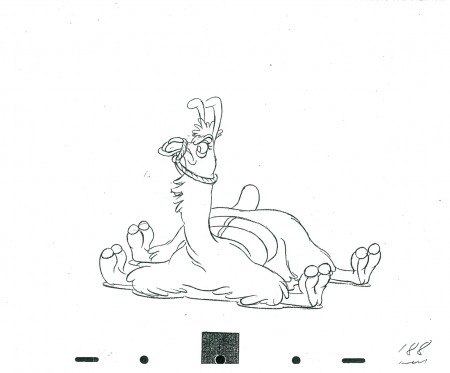 188
________________________
188
________________________
The following is a QT of this part of the scene with all the drawings posted here.
Thanks to John Canemaker for the loan of the scene to post.
Animation Artifacts &Events 04 Apr 2011 07:34 am
NFB Animation Chart
-In 1967, there was the Montreal World Exhibition of Animation Cinema. This was an historic event that brought together many of the world’s most famous animators. Ararwe occasion when Walt Disney and Max Fleischer would attend the same event. You can read more about it here.
At this event, an important document was sold. It was a large poster delineating the early history of animation through the Golden Age. The chart was developed by André Martin. Anyone who was anyone, back then, owned this poster. Mike Barrier and I recently discussed how long this thing lasted in our hands. Mine was taped to a wall, then moved, then moved again. Bit by bit, move by move, it started to tear and crumble. Eventually it was only a piece of its former self, and it didn’t make it through another move.
Recently, Tissa David gave me a bunch of posters she had in a tube in her apartment. Believe it or not, this poster was among them; so I decided to post the poster. The trouble is it’s so big – roughly 36×48. It meant scanning it in many many parts and trying to reassemble it in photoshop. It took a lot of time and had to be adjusted a lot in photoshop. Even sizing it so it could be posted was a pain in the butt. However, here it is in two versions.
- I scanned it full size for you to see.
- Then I scanned 8 parts of it so they would be larger and more readable in the thumbnail.
These 8 thumbnails are still small, but I couldn’t get them much larger without going to 12 or 16 parts. You’d lose all sense of continuity the original chart has.
You’ll have to spend some time with it if you want to get through it carefully, but you’re welcome to it. I hope my effort was worth the trouble.
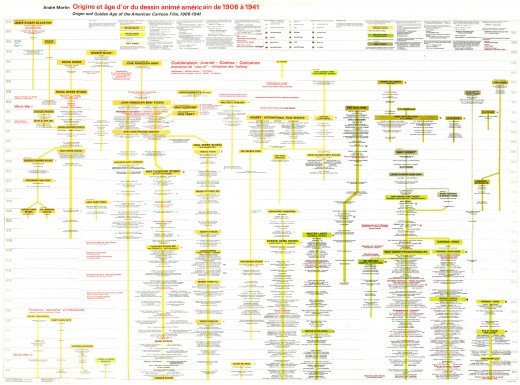
Full sized, click it to enlarge and read it as is.
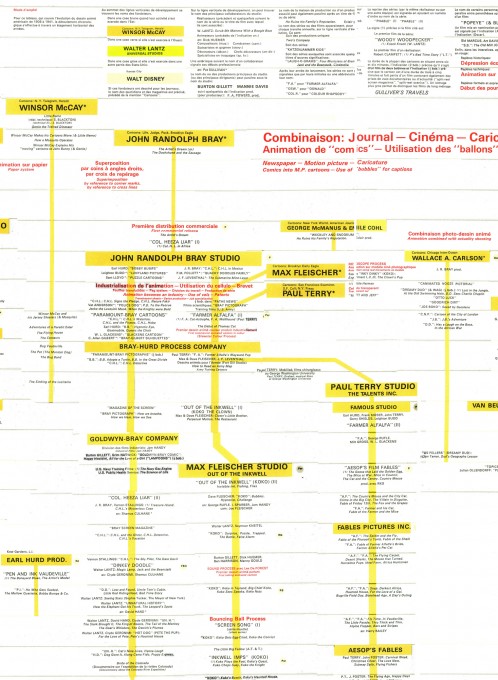 B
B
Upper Middle left – part
(There’s slight overlap to help you get continuity.)
Animation &Animation Artifacts &Disney 30 Mar 2011 07:04 am
Kahl’s Llama – part 3
- Well, I don’t have the music, but you can almost hear it in this wonderful piece of animation by Milt Kahl. It, of course, is part of Saludos Amigos; the dancing Llama. It’s yet another tour de force of animation done by Kahl. Donald Duck plays the panpipes as the Llama tries to dance to the bad rhythms. A complex piece of humor by the diverse animator.
This is part three with another couple to come. It’s a long scene. Many thanks to John Canemaker for allowing me to scan it.
As in the past, we start with the last drawing from last week’s post:
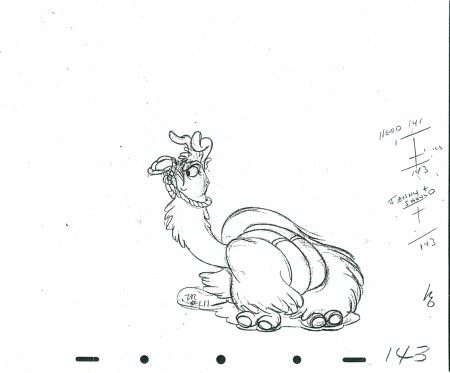 143
________________________
143
________________________
The following is a QT of this part of the scene with all the drawings posted here.
Animation &Animation Artifacts &Disney 23 Mar 2011 07:18 am
Kahl’s Llama – part 2
- This is the second part of the Milt Kahl dancing Llama from Saludos Amigos. It’s a wonderfully comic scene as the llama tries to dance to the poor flute playing of Donald Duck.
Thanks to John Canemaker for the use of the scene to post.
As with all such series, I start with the final drawing from last week’s post.
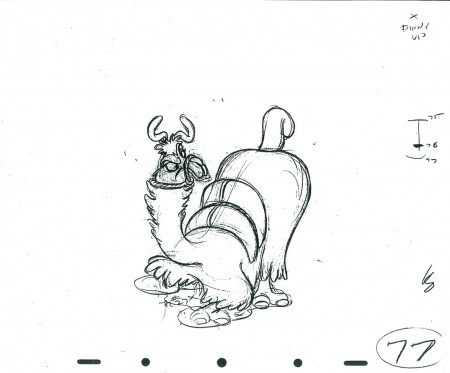 77
77
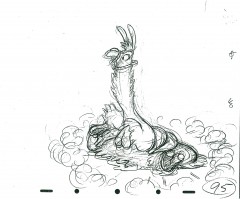 95
95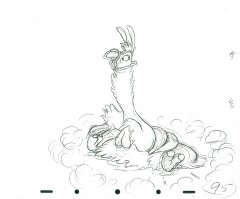 95cu
95cu
The rough and one cleaned up – a bit
The following is a QT of this part of the scene with all the drawings posted here.
Animation &Animation Artifacts &Disney 16 Mar 2011 07:32 am
Kahl’s Llama – part 1
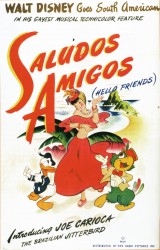 – Milt Kahl animated the lion’s share of the Lake Titicaca segment of Saludos Amigos. He took the idea of a llama dancing to the panpipes of a small boy; then he exaggerated the movements for the dance to Donald Duck’s poor attempt to play the flute music.
– Milt Kahl animated the lion’s share of the Lake Titicaca segment of Saludos Amigos. He took the idea of a llama dancing to the panpipes of a small boy; then he exaggerated the movements for the dance to Donald Duck’s poor attempt to play the flute music.
This was the first attempt that was done to use the material gathered by the Disney Good Neighbor mission to South America. Mary Blair and Jack Miller were the two who turned their sketches into a cartoon story. Their choice of Donald playing off the Llama made for some fine comic situations.
John Canemaker gave me the drawings posted here. It’s a scene with about 400 drawings, so it’ll take some time to post them all, but we’ll do it in parts. It’s a beauty. You can almost hear the beat as you watch the silent QT movie.
.
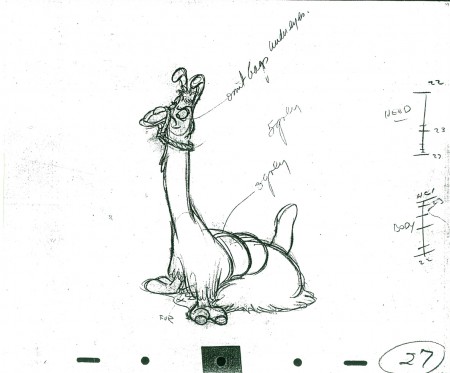 27
________________________
27
________________________
The following is a QT of this part of the scene with all the drawings posted here.
Animation &Animation Artifacts &Commentary 12 Mar 2011 08:37 am
Interviews
- On his website, Michael Barrier has been offering some of the many interviews he and Milt Gray recorded in preparation for his seminal animation history book, Hollywood Cartoons.
Two of these interviews have recently surfaced: Robert McKimson and John Hubley. Something comes across in these two interviews, something that doesn’t quite make it to the history books that try to include all the facts and figures, statements and theories. Personality is what is evident in these interviews.
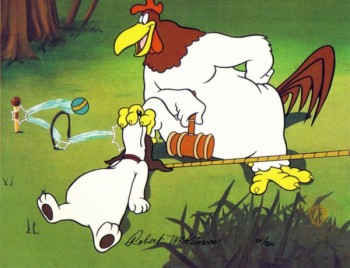 I’d read about Robert McKimson for years, but I never felt much about him. To be honest, I wasn’t a big fan of the films he’d directed for Warner Bros. They’ve always seemed a bit overanimated and don’t always take the shortest route to the gags. I’ve felt a flatness in these films, something even Friz Freleng’s films don’t have. There’s a tightness to Friz’ cartoons, a tightness that shows off the director’s mastery of timing.
I’d read about Robert McKimson for years, but I never felt much about him. To be honest, I wasn’t a big fan of the films he’d directed for Warner Bros. They’ve always seemed a bit overanimated and don’t always take the shortest route to the gags. I’ve felt a flatness in these films, something even Friz Freleng’s films don’t have. There’s a tightness to Friz’ cartoons, a tightness that shows off the director’s mastery of timing.
McKimson, to me, did incredibly beautiful artwork in those early model sheets for Bugs Bunny (well displayed on a sidebar piece on Mike’s site.) His animation certainly stood as strong in those shorts directed by Freleng. There was a bit more of a drive to the scenes he animated.
Reading the interview, I found a distinct personality. There was someone who needed to be in control, who had to take charge, yet never made waves when it didn’t happen. He quietly groused about the problem. A curiously complicated person. Suddenly, I felt more about McKimson the man than I had with all I’d read about him in the past. It makes me want to back up and revisit the shorts he’s directed. (Though not the Foghorn Leghorn films; I just flat out don’t like that character.)
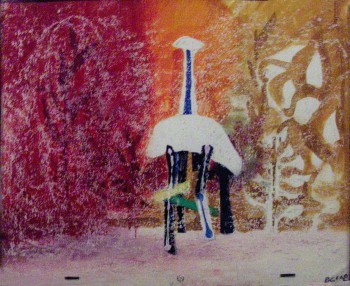 The John Hubley interview is different. I knew Hubley and knew this interview. Mike gave me a copy of it many years ago, and I’ve read it over some half dozen times. However, I can attest to John’s personality being right there.
The John Hubley interview is different. I knew Hubley and knew this interview. Mike gave me a copy of it many years ago, and I’ve read it over some half dozen times. However, I can attest to John’s personality being right there.
You get the feeling that it’s tough for Hubley to spare the allotted hour for the interview. He’s answering all the questions, but you feel like he wants to run to do something else. That was definitely John – always on the run. The only time he seemed at peace, to me, was when he was painting. For animation, when I knew him, that meant rushing out the Bgs for whatever piece we were working on. Given the short amount of time planned for each bit of artwork, it’s amazing how masterfully they all turned out.
The couple of times I made a comment to John about his past work – usually UPA, I was stopped. I remember riding high the day after I’d seen ROOTY TOOT TOOT for the first time. There was no doubt in my mind that I’d seen one of the great animated shorts of my lifetime. So I told John. He just looked at me for a couple of seconds, then turned and exited the room. I don’t know what was behind it, but I knew I wouldn’t get much about his past from him.
It’s amazing, then, to see how much and what detail Mike pulled out of Hubley, and it seems so effortless. In so many words, John tells Mike that he wanted no interference from others over his direction. You’re not quite sure he always fought for it, but there’s no doubt he wanted it. Information, I thought I knew, was clarified in the interview. I was and still am impressed by that information gathering.
Read these two interviews. They’re important. These people are the backbones of our industry, and we can only learn from them.
To that end, you should also know that Mike has quite a few more interviews on his site: Hugh Harman, Joe Grant, Brad Bird, Fess Parker, Frank Tashlin, John McGrew, Art Babbitt and Ward Kimball are all there, as are more. Just scroll down toward the bottom of Mike’s blog, and you’ll find quite a few links to the right of the screen. There’s a lot there on this site.
Animation Artifacts &Disney &Illustration &Story & Storyboards 10 Mar 2011 07:57 am
recap – Peet’s Wizard’s Duel
Now that I’m posting some of the illustrations from Bill Peet’s book, Capyboppy, I thought it might be a good time to recap his storyboard for the wizard’s duel in Sword and the Stone. It’s not bad to compare his storyboard drawings with his children’s book illustrations.
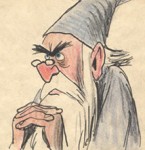 – Here is a preliminary storyboard done by Bill Peet of the Wizard’s Duel from Disney’s Sword In The Stone. It’s another gem on loan from John Canemaker, and is a companion to the piece I posted last Friday by Peet. The oddity of this board is that it’s dated April 1949. (The numbers at the bottom of the board clearly read “449.”) I didn’t have any clue that this film was in development that early. The book was published in 1938, so it’s quite feasible.
– Here is a preliminary storyboard done by Bill Peet of the Wizard’s Duel from Disney’s Sword In The Stone. It’s another gem on loan from John Canemaker, and is a companion to the piece I posted last Friday by Peet. The oddity of this board is that it’s dated April 1949. (The numbers at the bottom of the board clearly read “449.”) I didn’t have any clue that this film was in development that early. The book was published in 1938, so it’s quite feasible.
If that date is accurate, it’s amazing how close the characters stay to their final models. This could easily be explained with the heightened use of xerography in animation after 1958. Post 101 Dalmatians, this loose style was easy to translate into animation, and Ken Andersen was easily able to adapt to this style by Bill Peet that all of the animators in the studio loved.
 A
A
Click on any image to enlarge
 B
B
Note in row 2 how the spider turns into the tiger’s face; it’s a graphic turn. This never would have made it to the final in a Disney film, and it didn’t.
 C
C D
D
I love how extra drawings which have been pulled make it to the bottom of the second board.
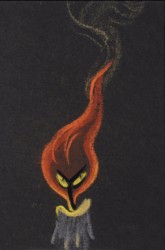 - I always thought Disney’s The Sword In The Stone a somewhat underrated film. The background art is sensational, and several sequences are brilliantly animated.
- I always thought Disney’s The Sword In The Stone a somewhat underrated film. The background art is sensational, and several sequences are brilliantly animated.
Bill Peet‘s adaptation from TH White‘s book, The Once and Future King, loses some of its poetry in the adaptation, but the book’s storyline features a lot of rambling making it hard to construct a screen story. I’ve watched this film quite a few times over the years, and somehow it always gives me a bit of a charge that comes with many of the older classics.
The extras on the dvd seems to consist predominantly of storyboard drawings by Bill Peet. So why not show them off? There’s no continuity to attend to, hence the images are gathered in small clusters. The sequence everyone jumps to analyze and discuss is the Wizard Duel between Merlin and Madame Mim (animated by Milt Kahl.) Consequently, a lot of the drawings on the dvd come from this sequence. I, personally, would have loved seeing some of the squirrel section. I found it quite moving and full of real character stuff. It would be nice to see how Peet developed this.
There’s no hint of a continuity on the dvd, but I’ve heard that the storyboard drawings in the vault are just placed in manilla envelopes with no suggestion of an order. It would make sense that they’ve just plopped these images on the dvd as they have with no order, details or related information.
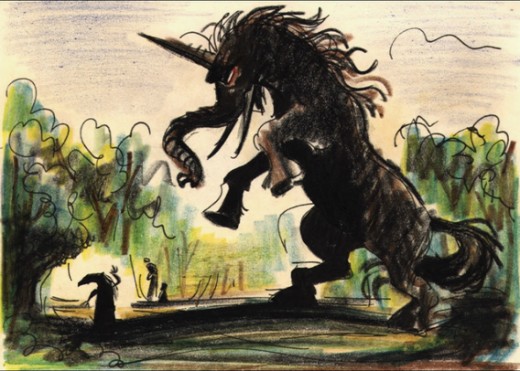
_______Here’s a creature that never made it to the battle of the wizards.
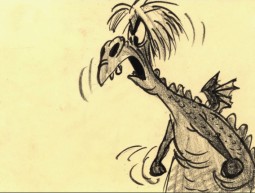 _
_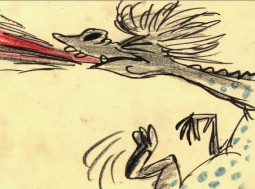
_________________________(Click any image to enlarge.)
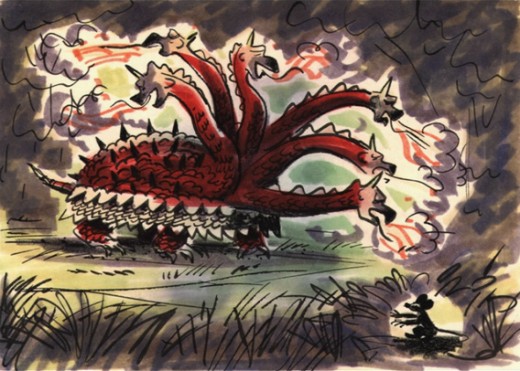
___________Another fantastic creature that didn’t make it into the film.
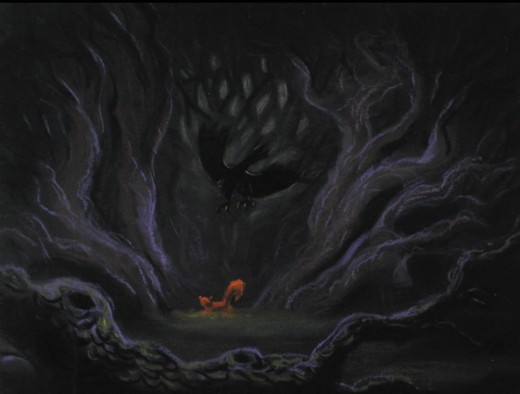
I’m not sure if this drawing is also from the duel. Or was it another sequence where Wart becomes an animal – cut out of the film?
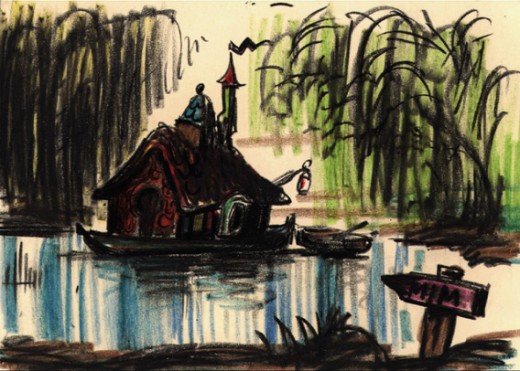
This looks like it may have been planned as a home for Madame Mim. Did it inspire anything for The Rescuers?
_____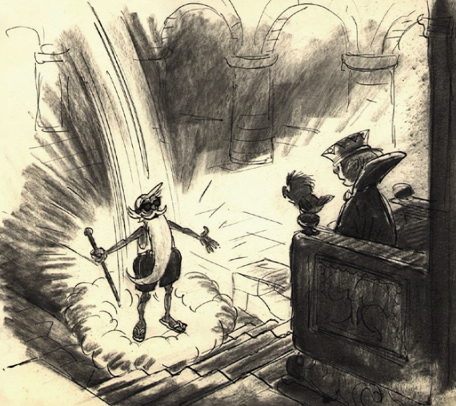
Here are a couple of models Peet obviously did –
_______________________probably more for himself than anything.
______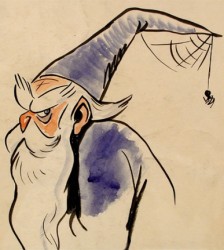 _
_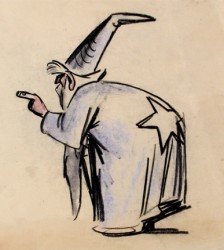
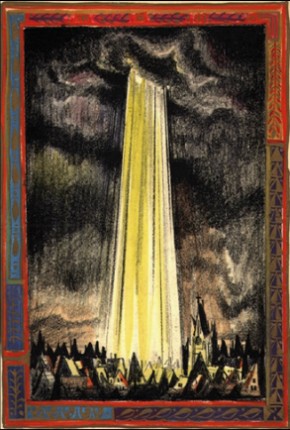
Animation &Animation Artifacts &Disney 09 Mar 2011 08:53 am
Tytla’s Laughing Gauchito – part 2
- Here is the remainder of the Bill Tytla scene from The Laughing Gauchito.
As I’d written in the past, this was part of a series of shorts that would have been released theatrically as stand-alone films. The Flying Gauchito had already been released, and this film was to follow. However, Disney, himself, put a stop to this short even though it had gone into production. Jack Kinney was directing with Tytla, Frank Thomas and Ollie Johnston already animating on it. Walt felt that it was too much of a one-note film, and he didn’t like that, so the “Gaucho” series was stopped early on.
You should look into J.B. Kaufman’s excellent book, South of the Border; it gives a full accounting of this film.
Here we start with the last drawing from Part 1 and continue to the end of the scene:
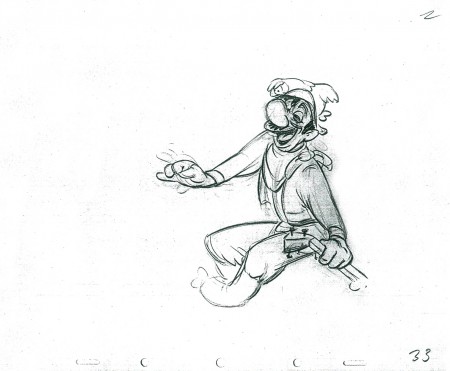 33
________________________
33
________________________
Here’s a QT of the scene with all the drawings from the scene.
Many thanks to John Canemaker for the loan of the scene.
